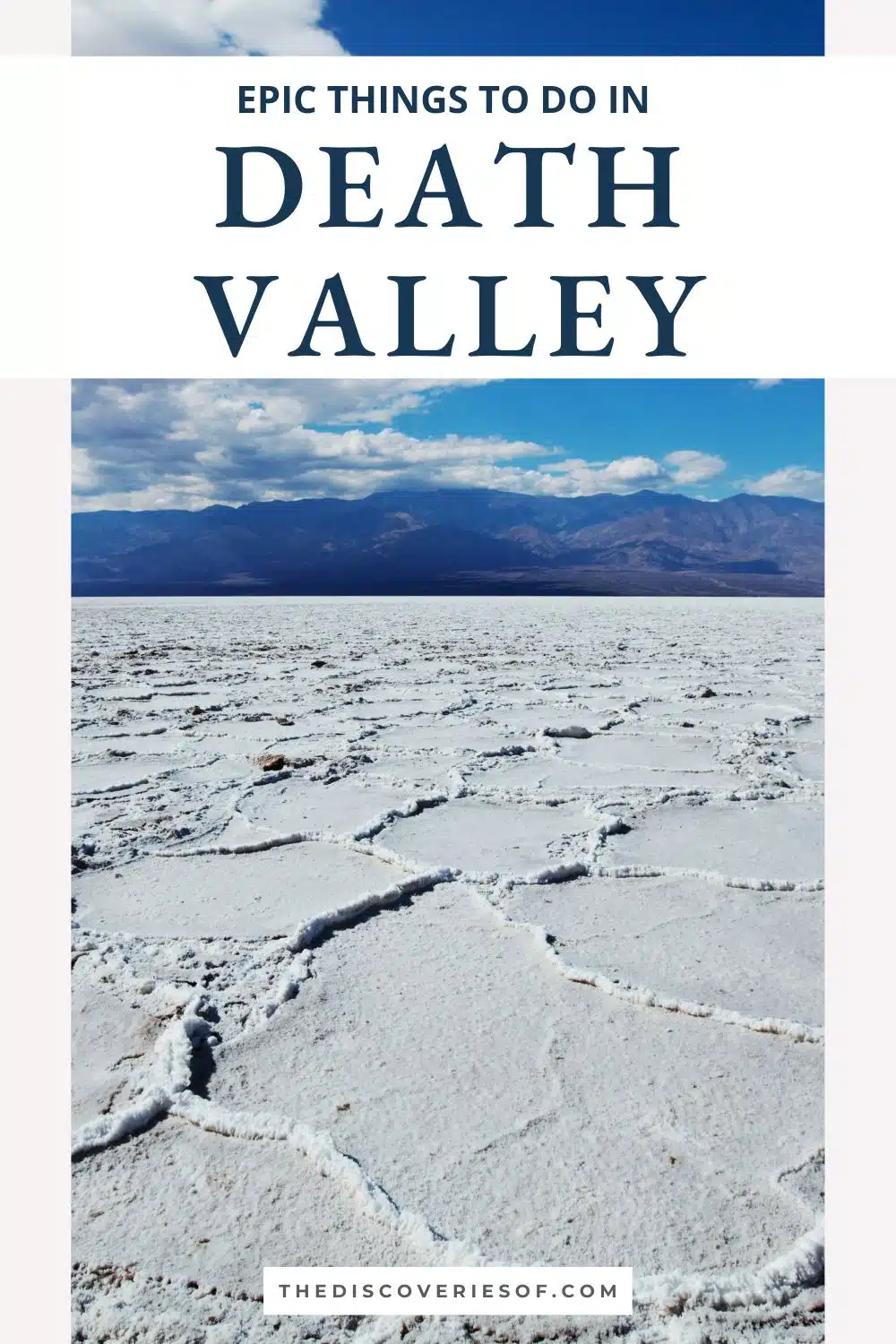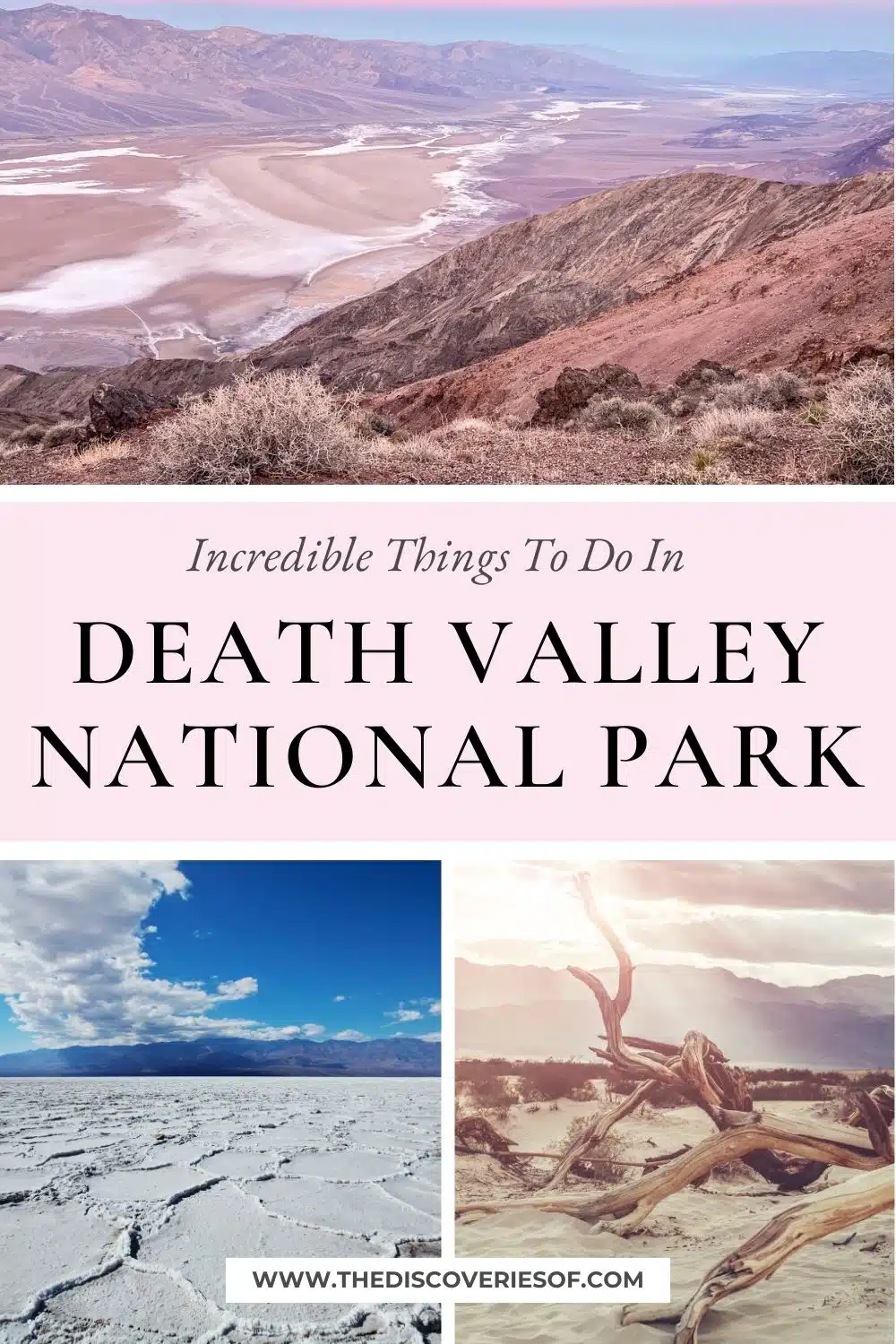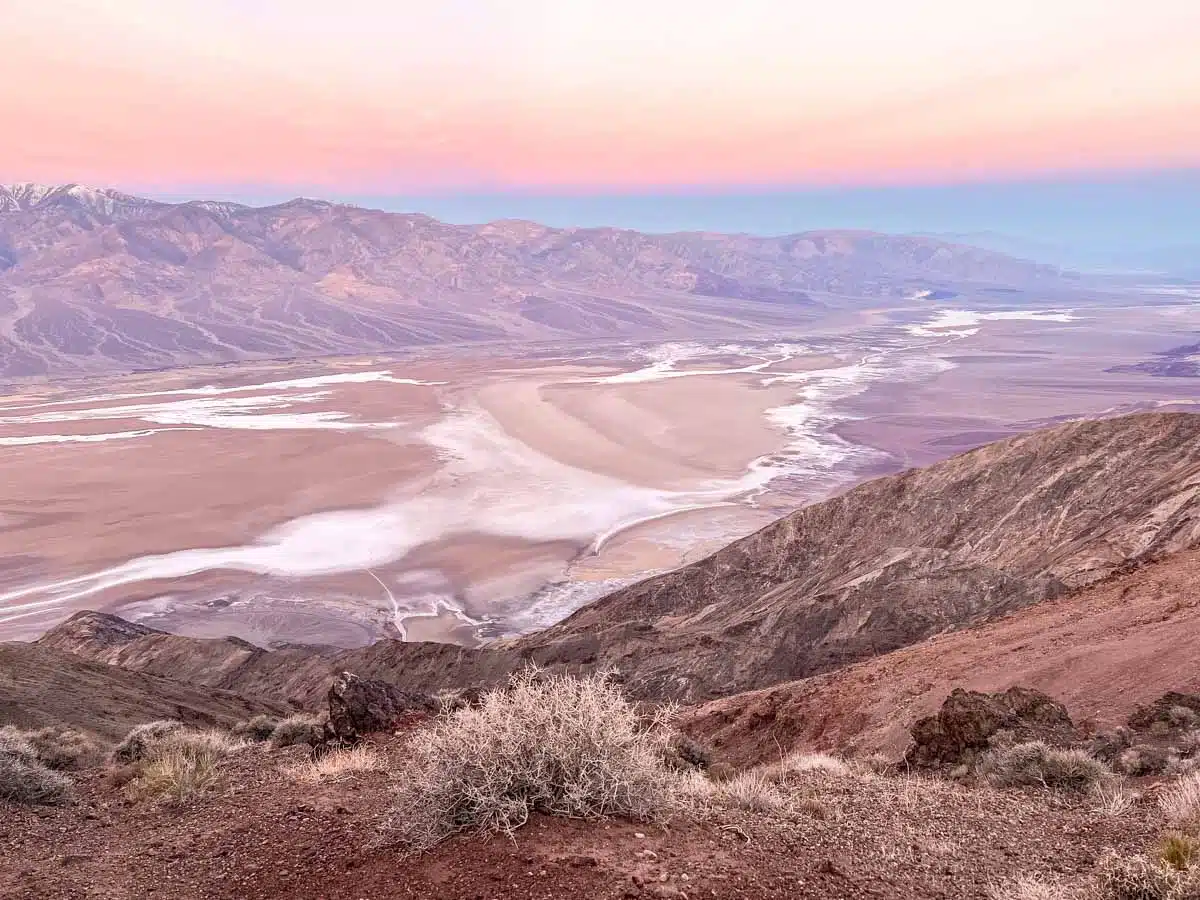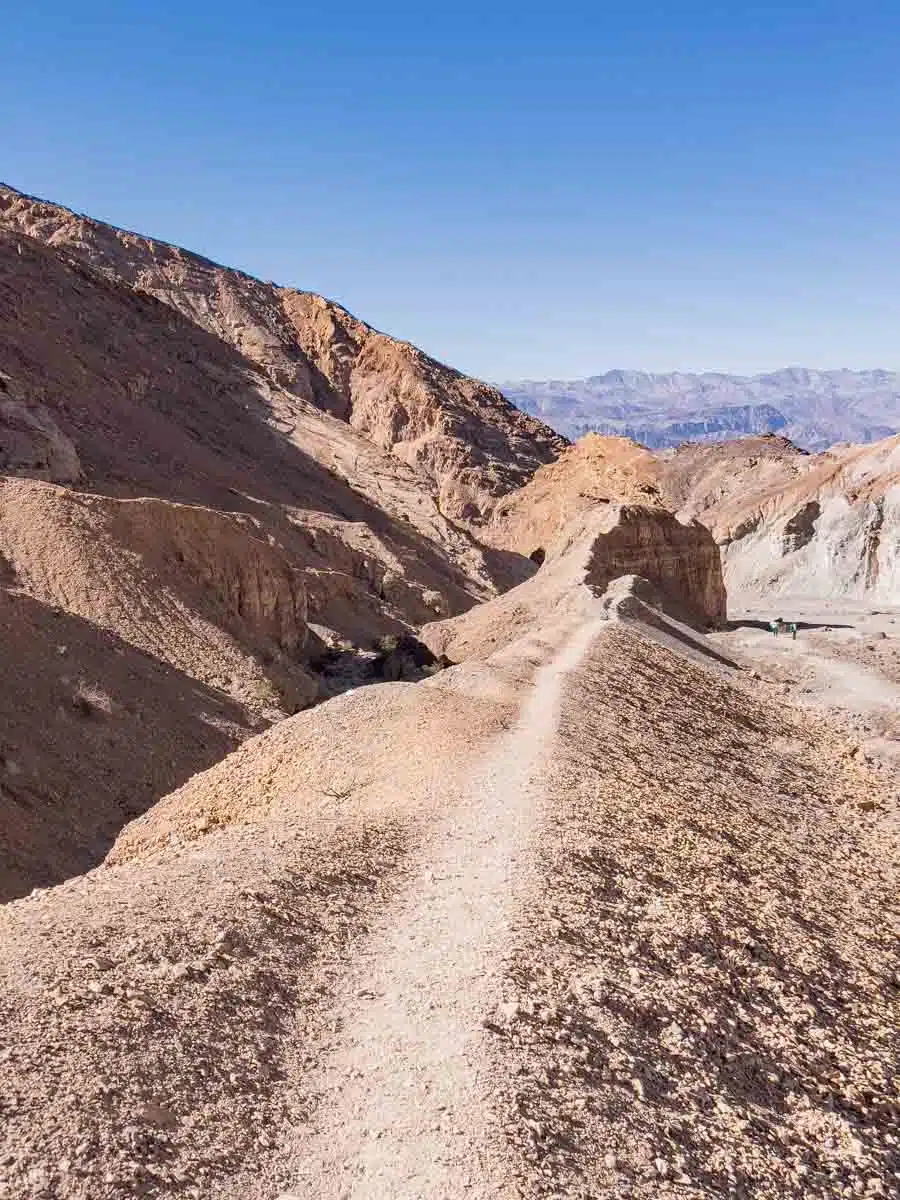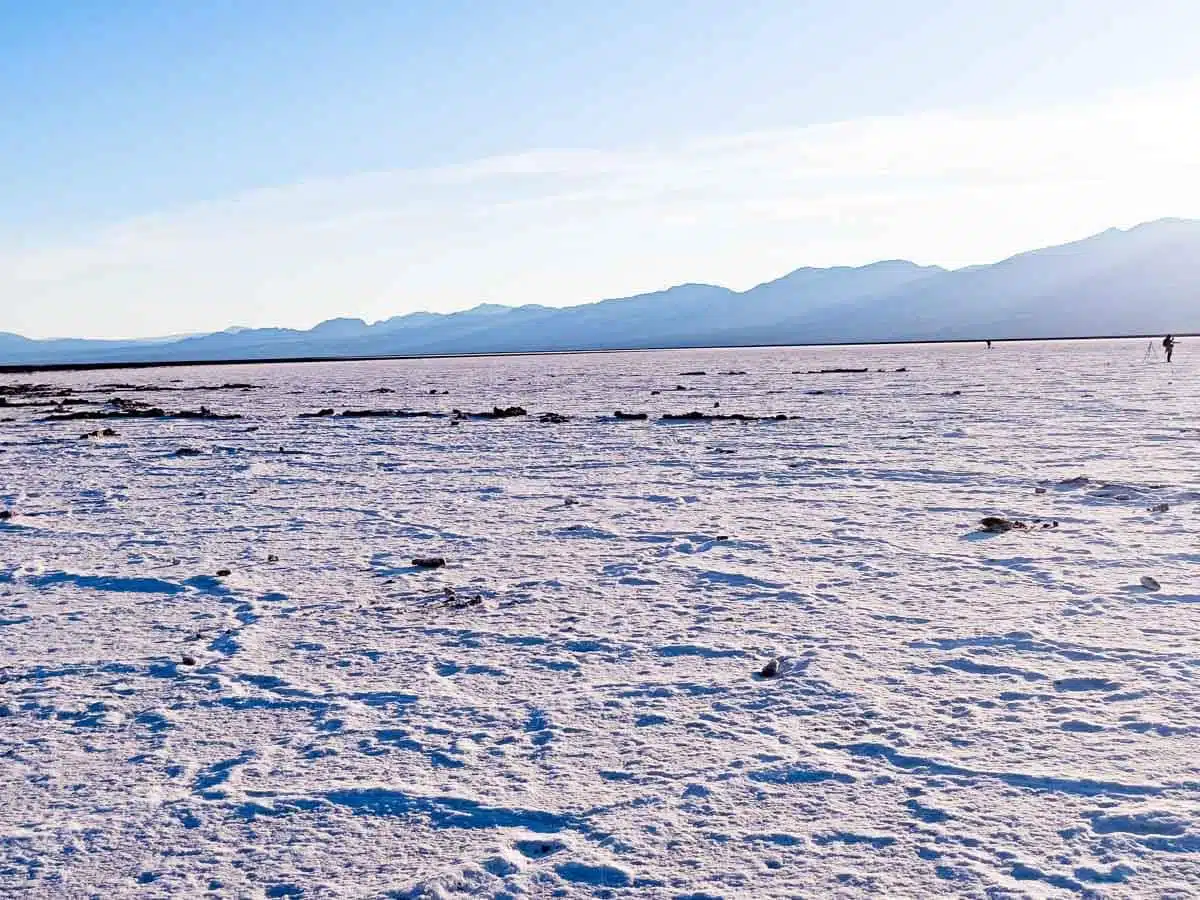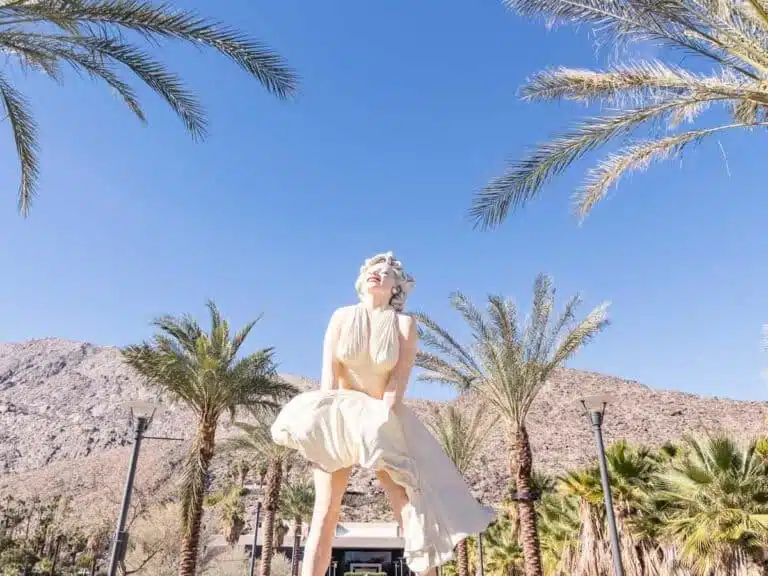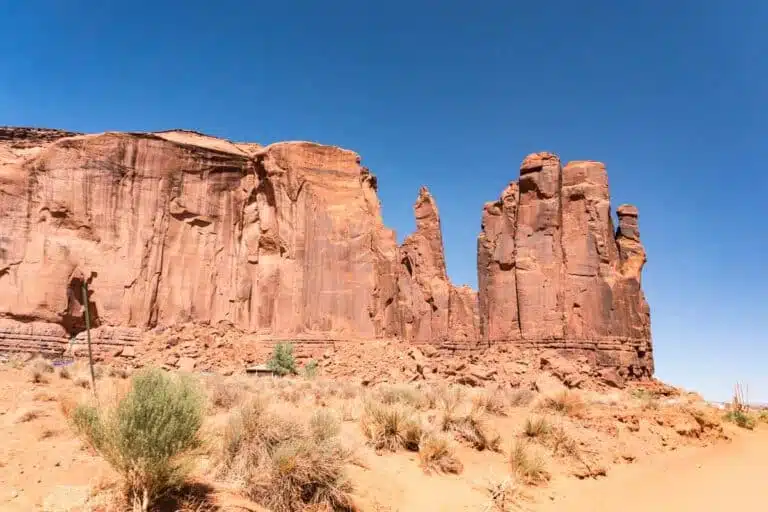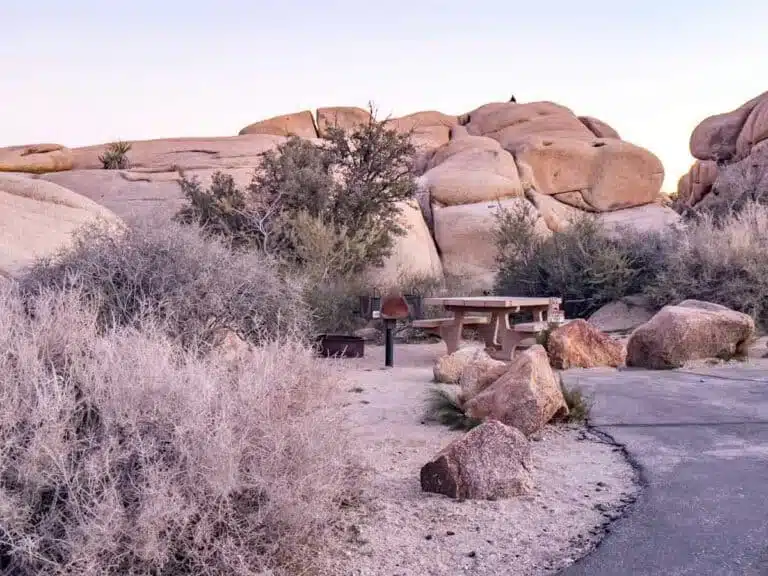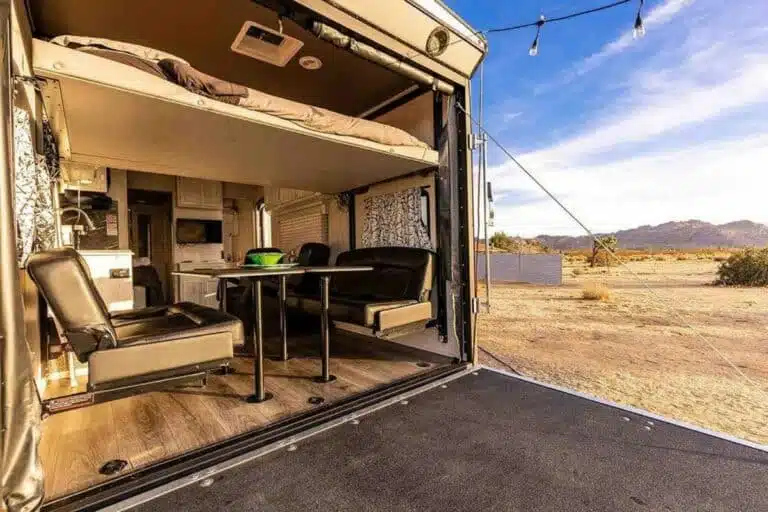Ready to discover epic things to do in Death Valley National Park? Incredible sunrises, salt flats and scenic drives await.
Death Valley National Park is a straight-up epic destination. No if, no buts, no quibbles.
If you’re planning on visiting Death Valley for the first time, let me tell you, you’re in for a ride.
The name might sound a little grim, but the reality is a series of landscapes that are out of this world – from watching a kaleidoscopic sunrise light up the valley basin to hiking into the midst of multilayered canyons – Death Valley is packed with amazing landscapes for you to explore.
It’s one of my favourite destinations in California – a slice of Martian terrain plopped in the state’s far eastern reaches.
That’s enough about me though. Let’s help you plan your trip to Death Valley.
This guide takes a deep dive into the must-see sights in the park – from better-known places like Badwater Basin to hidden gems like the Charcoal Kilns. I also cover a series of practical tips to help you with planning your own visit at the end of the article.
Ready to delve into all the incredible attractions that bring visitors back to this formidable piece of the planet year after year? Of course you are. Let’s go.
Top Tip
Although the park has reopened, many of the roads and attractions in Death Valley are closed after the flooding in summer 2023. Check the National Park’s website for up-to-date information before you go.
Best Things to Do in Death Valley National Park
Catch the Sunrise at Dante’s View
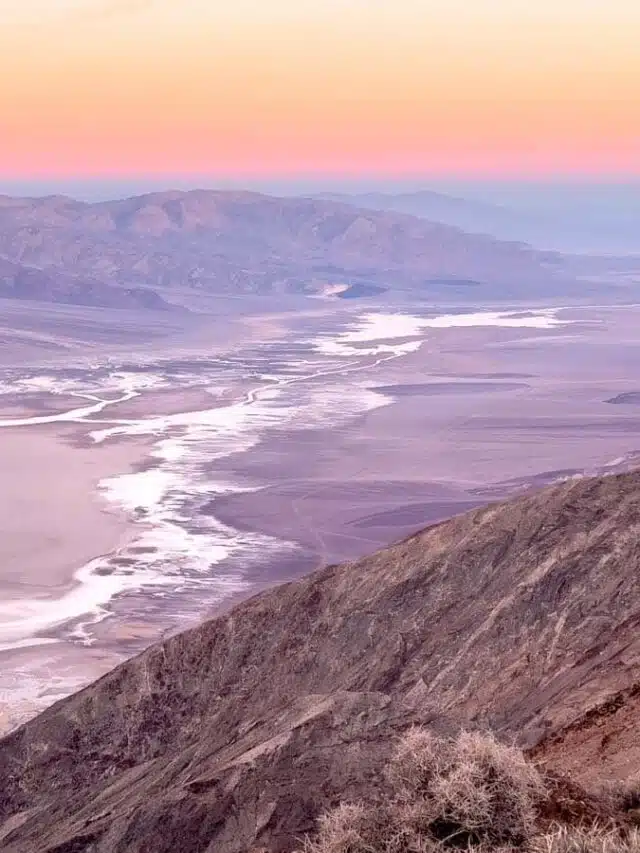
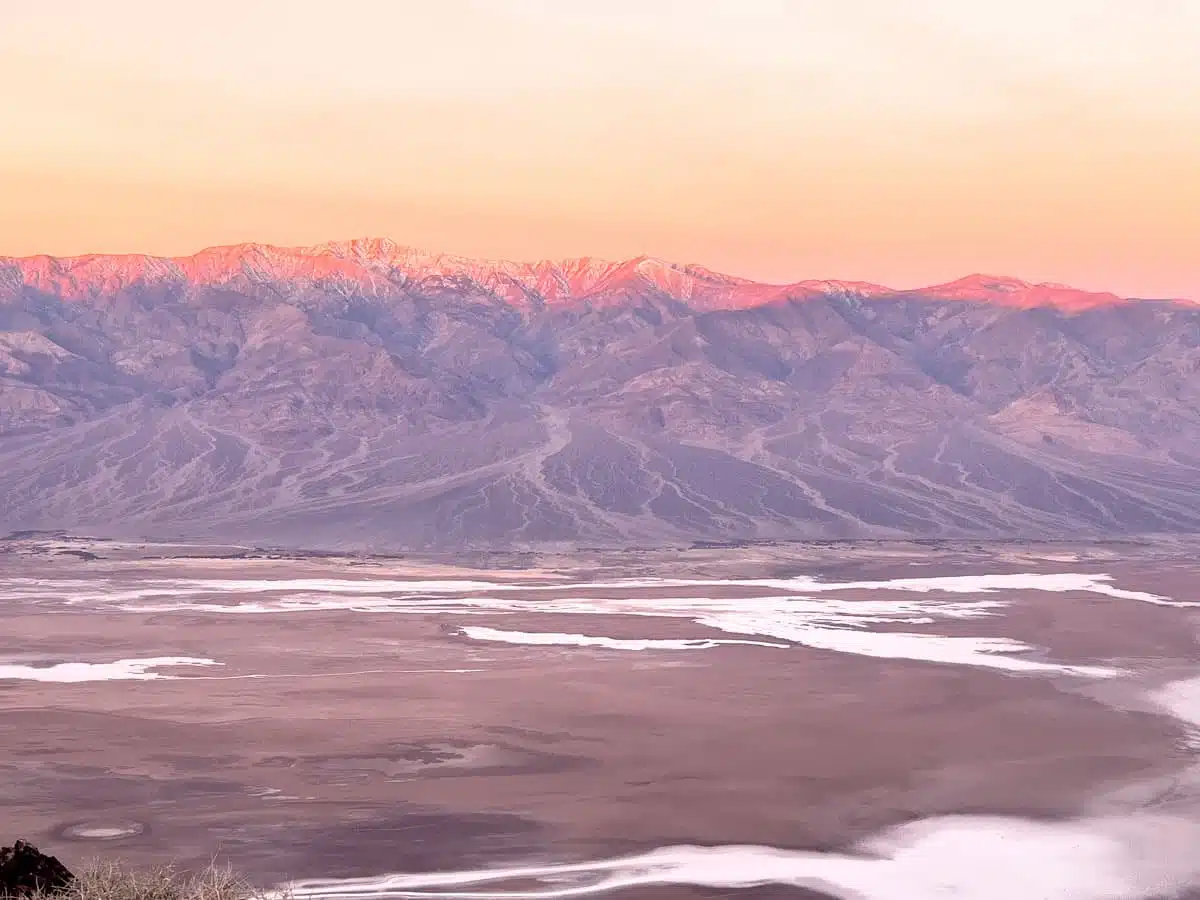
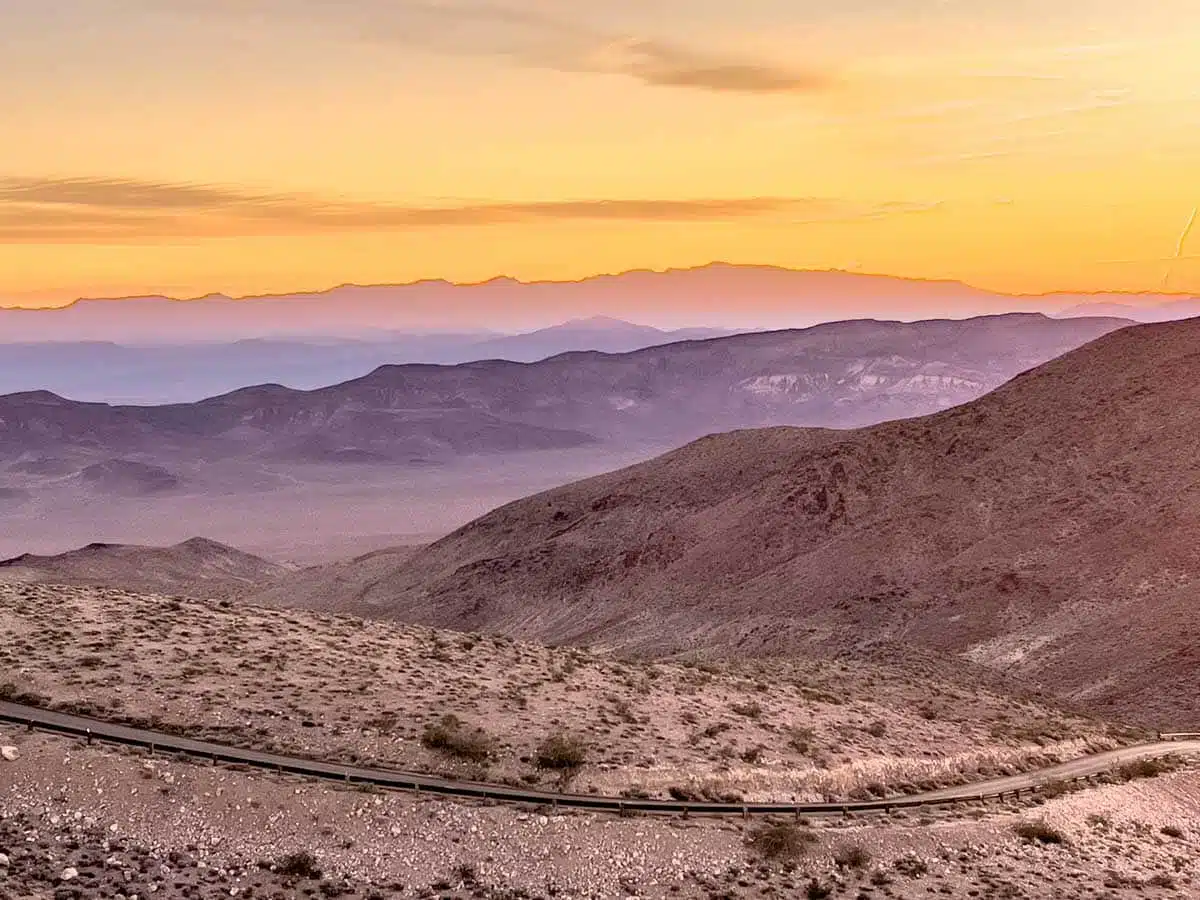
If you only have time to take in one EPIC viewpoint in Death Valley, make it Dante’s View.
The views alone guarantee Dante’s View a spot in any guide to the top spots in Death Valley National Park, but when you throw a spectacular sunrise into the mix and it’s almost unbelievable.
What’s the draw? Trundle up in the car to the viewpoint’s lofty 1,670 metres, to look down over the breadth of Death Valley… all the way across the Badwater Basin to the mountains on the far side.
It’s a little out-of-the-way to get to, but the view alone is worth it. The browns and oranges of the mountain rock contrast the silky whites and purples of the Basin, making it seem like you’re gazing upon a winding river of milk. Stunning!
I’ll warn you – it is freezing at sunrise (seriously, I thought my ears were going to fall off) so wrap up warm and bring a hot drink – you’ll want to be up here for hours.
Hang Out At America’s Lowest Point: Badwater Basin
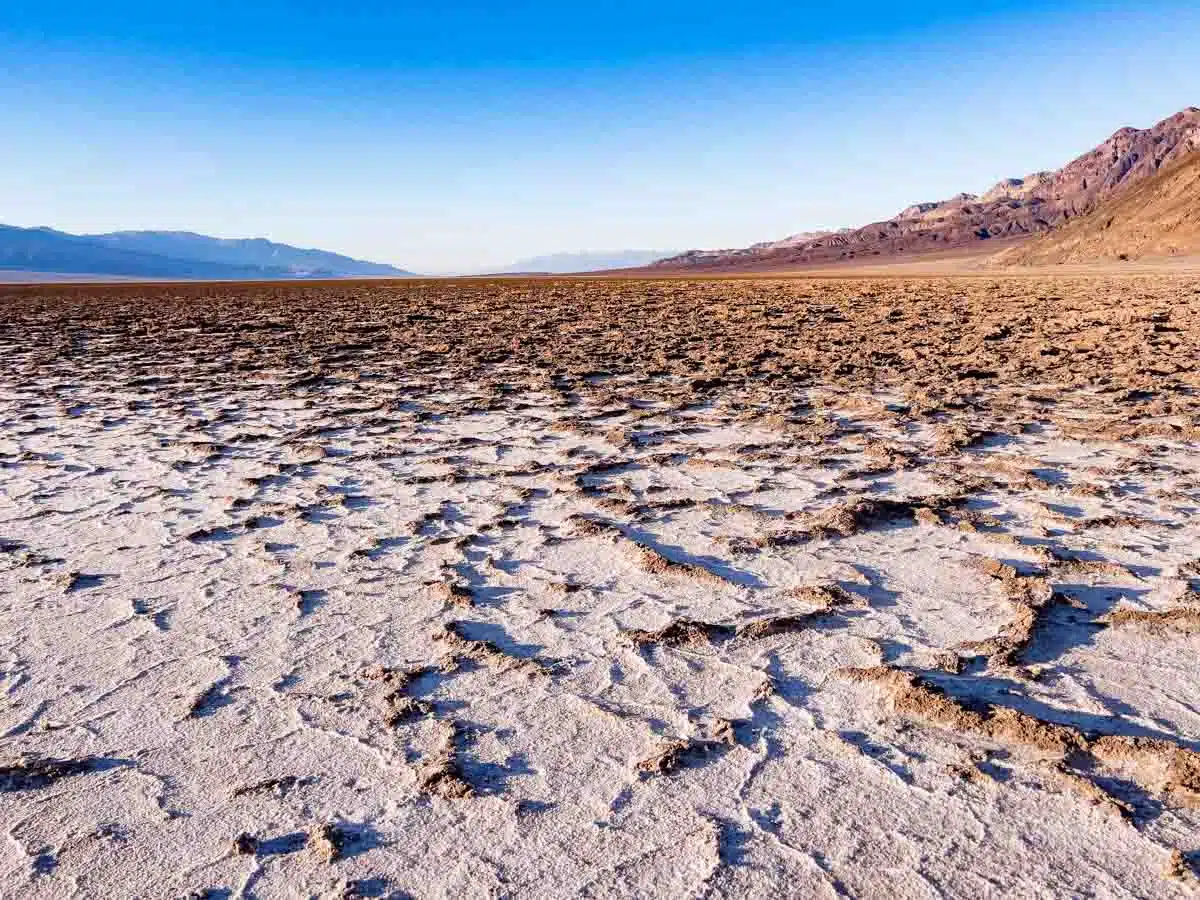
When it comes to Death Valley attractions, Badwater Basin is always going to be high on the list.
At 86 metres (282 feet) below sea level, Badwater is the lowest point in North America.
That’s not all though – Badwater Basin just so happens to be a vast salt flat. Hundreds of intricate geometric shapes tessellate like sunlight on the bottom of a pool – all in all, it’s a fascinating sight that looks more like it belongs in Bolivia than in good ol’ California.
Its unique geography not only paves the way for some weird views, it also means that Badwater has a few tricks up its sleeve – for example some of the hottest temperatures on Earth have been recorded here, with highs of 56℃ (134℉).
Most people just take a few steps beyond the boardwalk. But if you’re like me, you’ll want to walk the 1.8-mile path into the heart of the basin to fully ensconce yourself in the shimmering, salty vista.
It’s super easy to get to, but the parking lot fills up fast, so get there early.
Marvel at the Views from Zabriskie Point
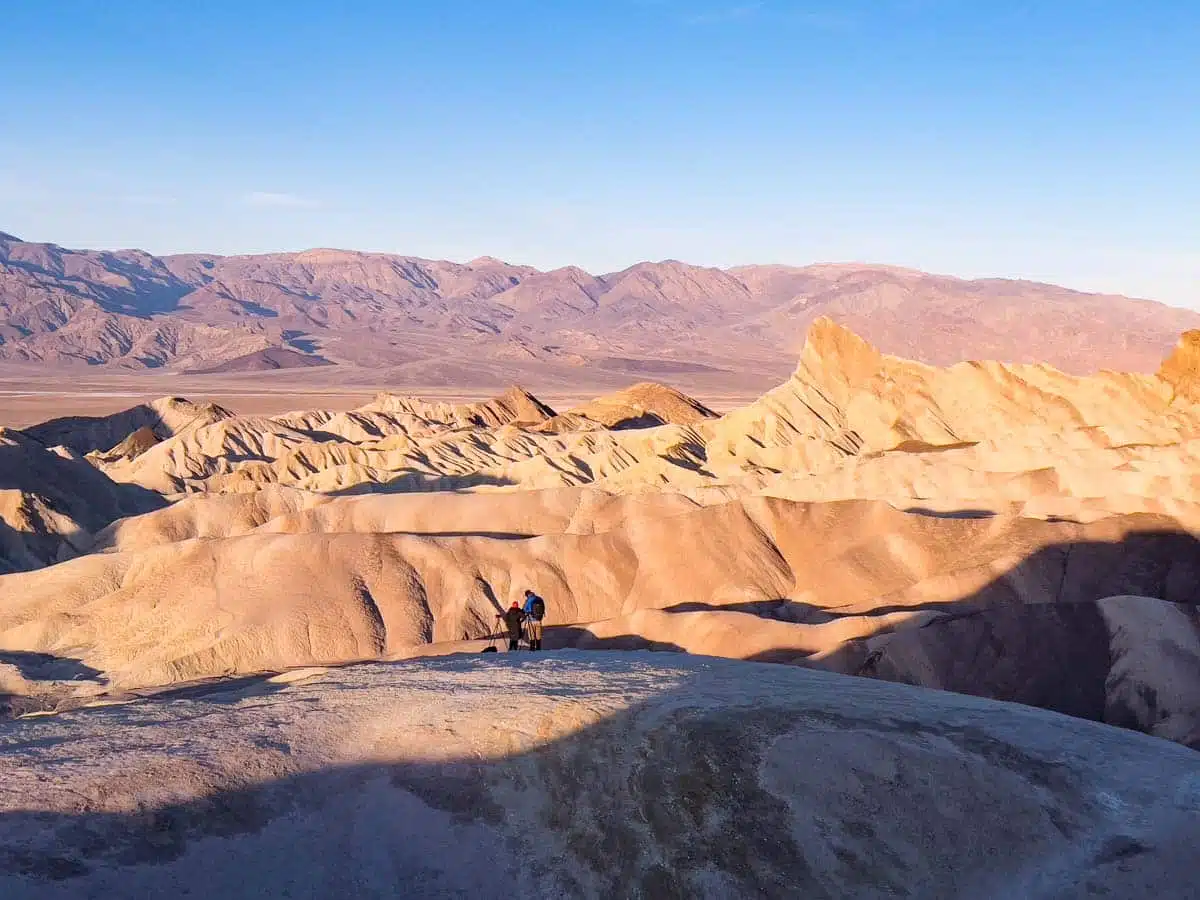
Zabriskie Point is another of Death Valley’s epic attractions. Just a short hike from the parking lot, it boasts one of the park’s most glorious vistas.
Can you conjure up images of jutting multi-hued stone carved by wind and water? Zabriskie Point overdelivers – with a dramatic panoramic view of the valley that is, quite frankly, obscenely pretty.
Sure, it’s pretty, but what are you actually looking at? The remains of Furnace Creek Lake, a lake that dried up millions of years ago, leaving a tableau of gullies and ridges in its lake.
It’s popular, so prepare yourself for crowds if you come during peak season.
Top Tip
You may also want to bring a warm jacket, as it’s at a much higher elevation than the floor of the valley, so it can get chilly depending on the season.
Hike Over The Mesquite Flat Sand Dunes
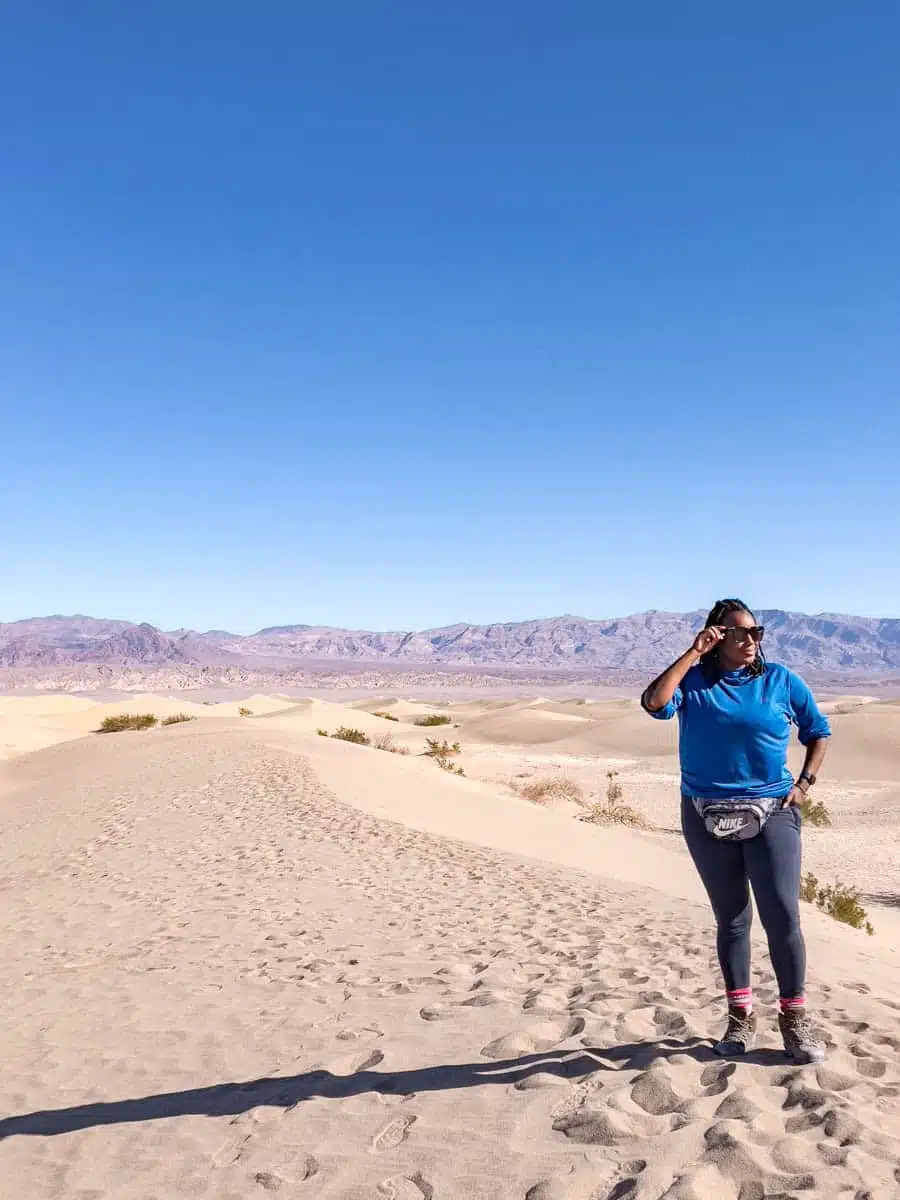
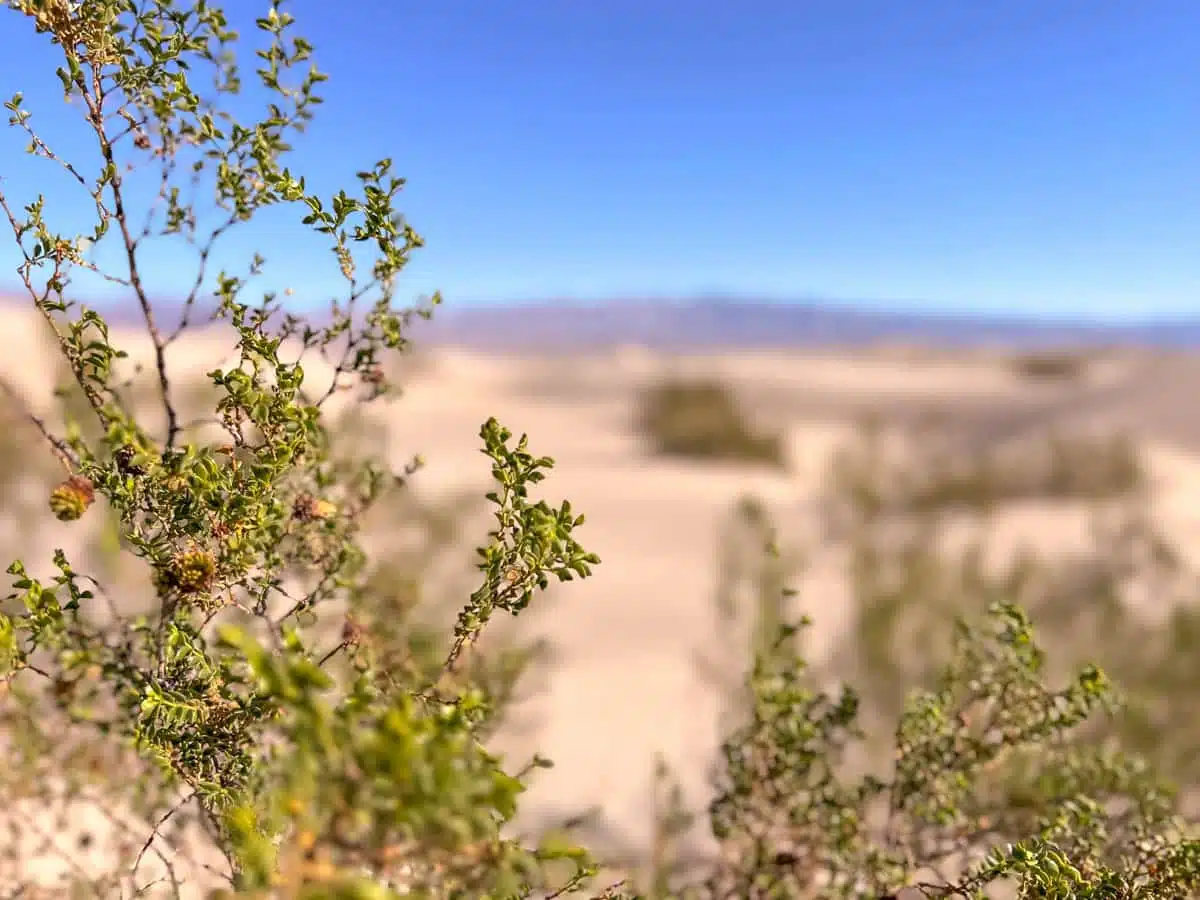
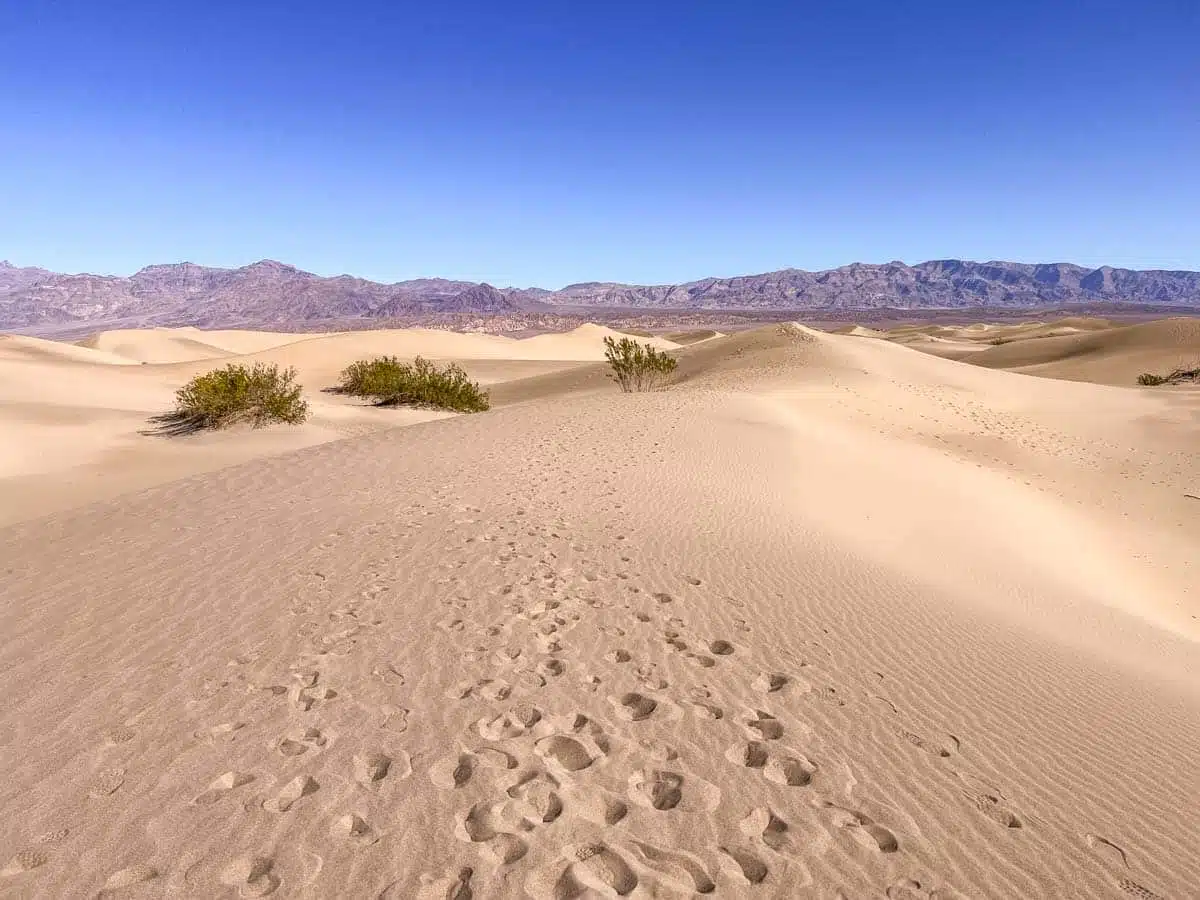
Although Death Valley is actually home to five dune fields, the Mesquite Flats are the most popular.
With majestic purple mountains in the distant background and golden dunes before you, it’s a photographer’s dream come true.
Strike out onto the dunes from the parking lot as far as you like, but – be warned – walking in loose sand, particularly in the heat, is no easy task, so save some energy for the return trek.
That said, the further out you get, the more solitude and better views you get… isn’t that always the way.
Top Tip
The heat and the sun are no joke – ensure you’re well protected from the sun and have plenty of water. Don’t venture further than you can safely return.
See the Volcanic Remains at Ubehebe Crater
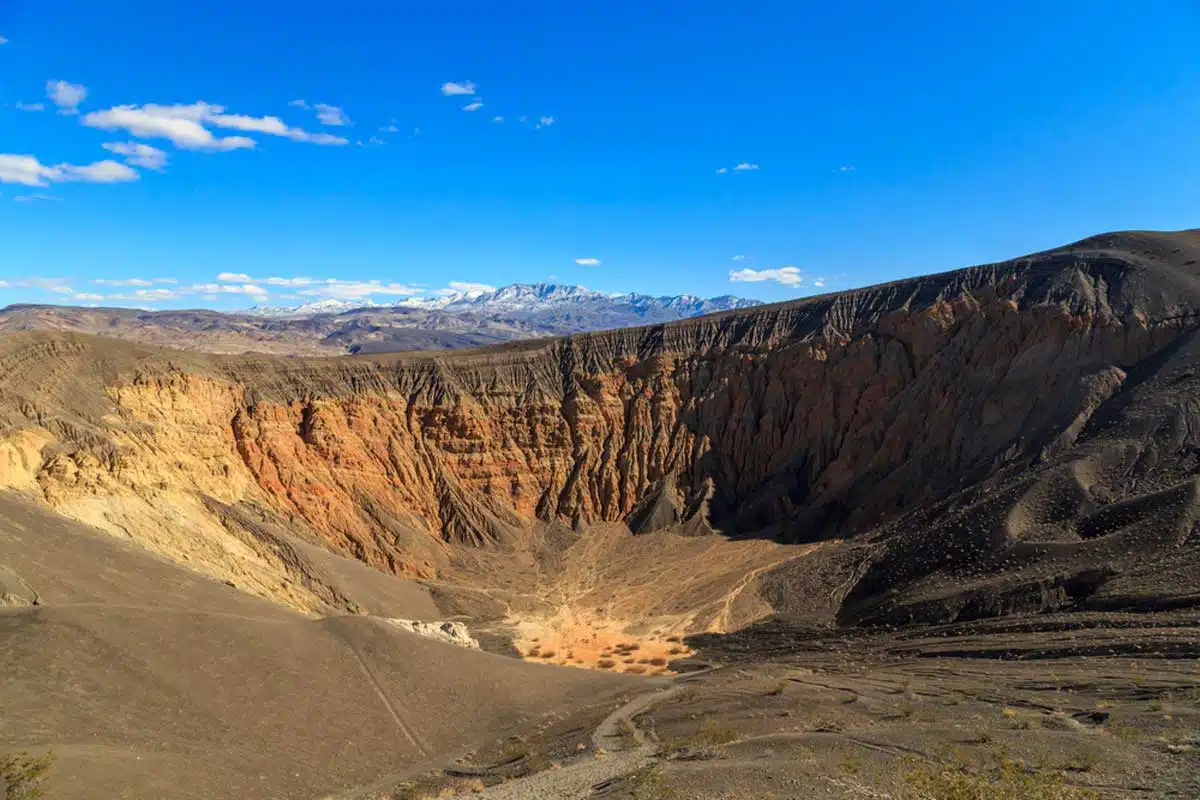
Ube-what-now? It’s pronounced “oo-beh-heh-bee” and looks like a meteor’s strike zone, but Ubehebe is a volcanic crater in the valley.
It’s a maar volcano crater – in other words a crater created by a steam explosion as magma rises towards the earth’s surface and meets groundwater, building in pressure until it explodes, leaving a crater in its wake.
You can hike around the rim (a mere 1.5 miles), trek down to the crater, or admire the view from the parking lot. Be warned, it can be tempting to descend into the crater, but the ascent can be tough – make sure you’re prepared with lots of water and sturdy shoes.
Although Ubehebe is the most iconic of the craters in Death Valley, there are others in the park too – including nearby Little Hebe, which was created by the same process.
Top Tip
The crater was closed on my most recent trip to Death Valley in November 2022 due to flash floods on the road to the crater. Check with the NPS if it’s open before attempting to go.
Walk in the Footsteps of History in Death Valley’s Ghost Towns
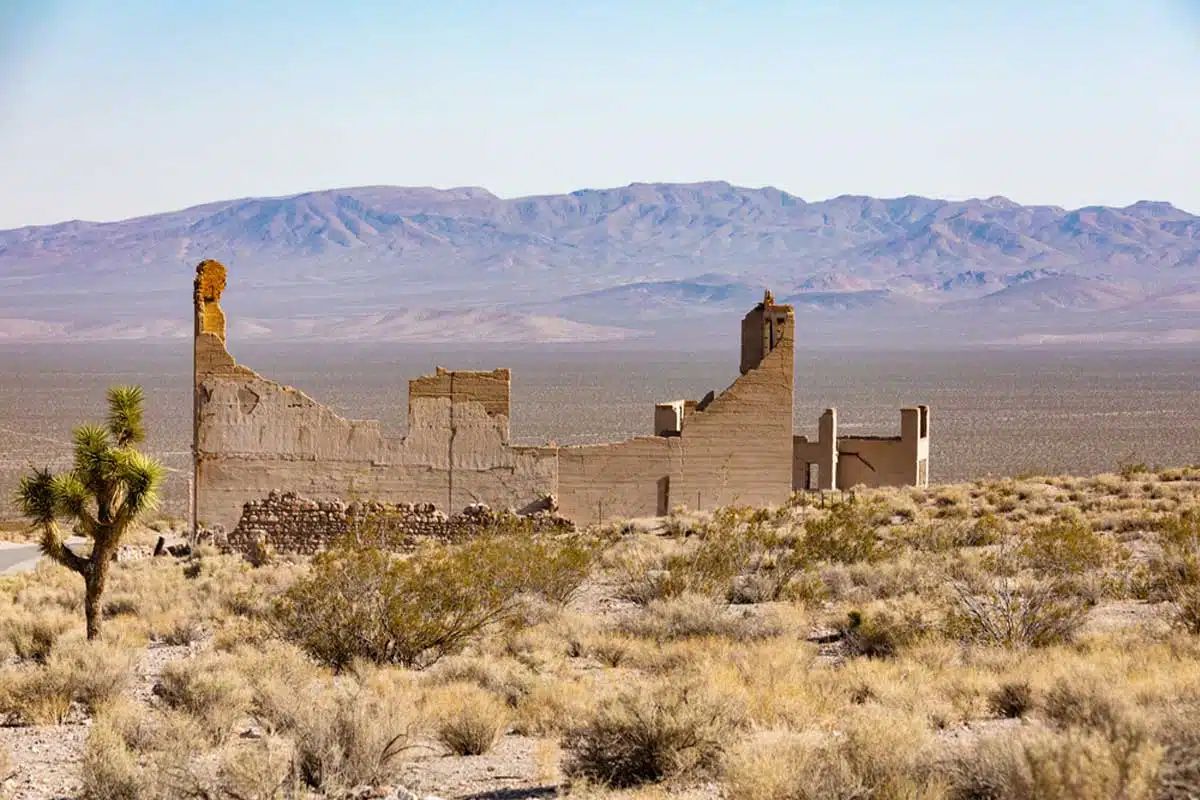
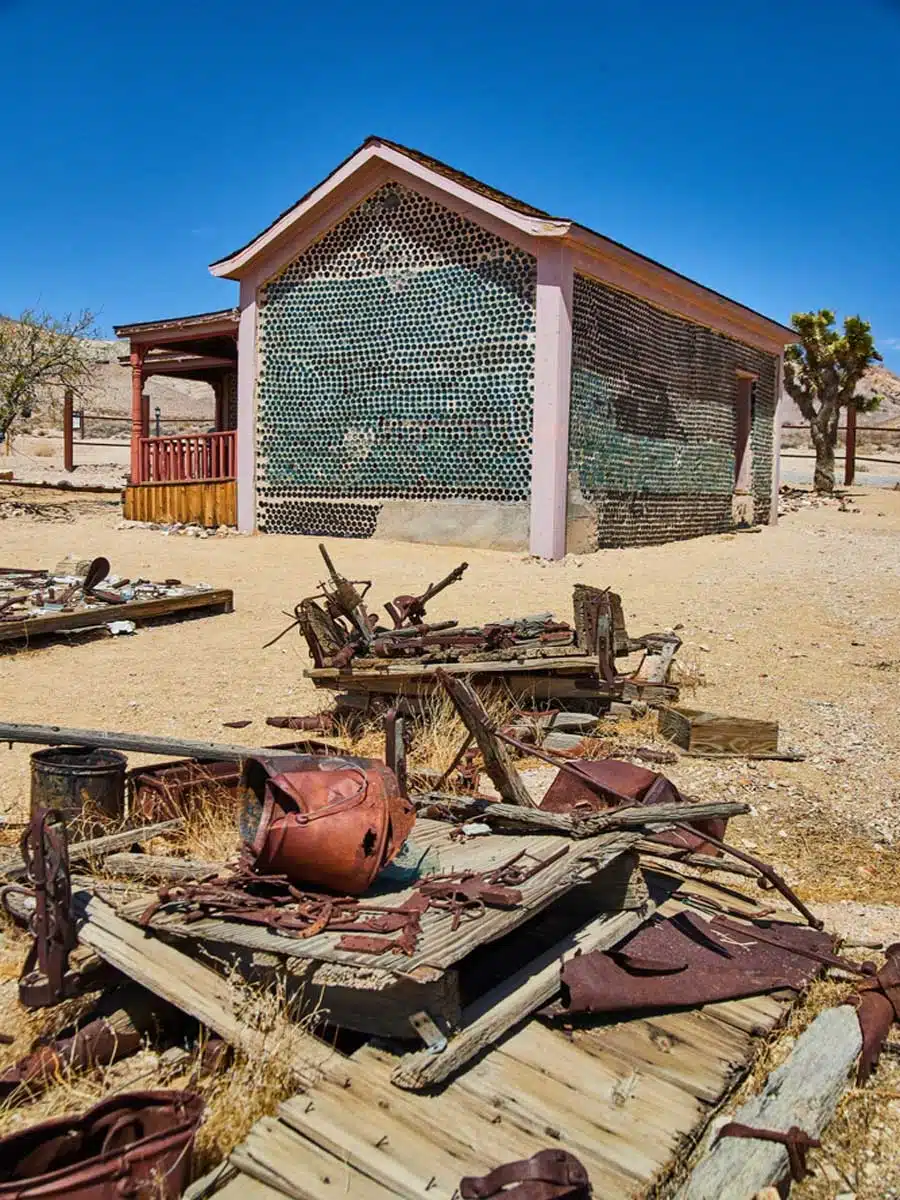
Were it not for the smattering of so-called “ghost towns” spread across the park, it would be hard to believe that these inhospitable plains were once home to small communities of people drawn in by the gold, copper and other precious minerals that were mined in the region.
Visiting the ghost towns is a fascinating experience, pulling you into the remains of history, relics of the area’s Boom and Bust era.
Rhyolite is the best-known ghost town which is funny given that it’s not even in Death Valley and actually sits across the state line in Nevada. At its peak, the town had a population of 5,000 and even had its own Opera House before the gold ore ran out and people moved elsewhere.
Others like Ballarat, Leadfield, Chloride City and Skidoo are smaller in comparison, but no less interesting.
PS. Think you’ve heard the name Ballarat before? It’s famous for being the place where Charles Manson hid out in the 1960s.
Check Out the Devil’s Golf Course
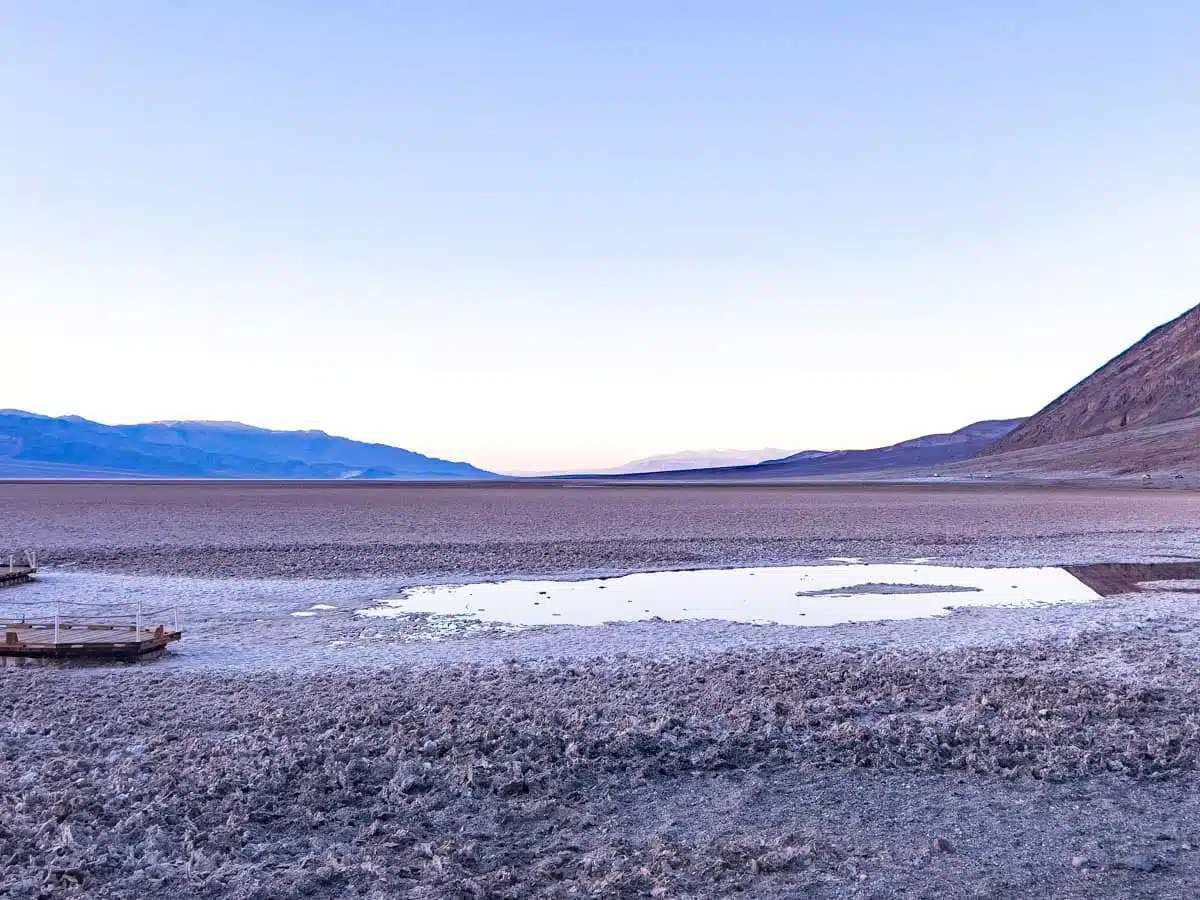
Imagine a landscape maintained by the worst groundskeeper ever and you’ll come close to conjuring up an image of the Devil’s Golf Course.
Looking like the divets of a thousand golfers pockmark the earth, it’s actually a lumpy salt (not-so) flat that forms part of Badwater Basin.
You’re not allowed to actually walk on the Golf Course – probably down to the sharp salt crystals on many of the mounds and the fact that doing so damages the unique ecosystem.
Nonetheless, it’s worth a quick visit as you can see the area from the path leading from the parking lot to Badwater Basin.
Tackle The Mosaic Canyon Hike
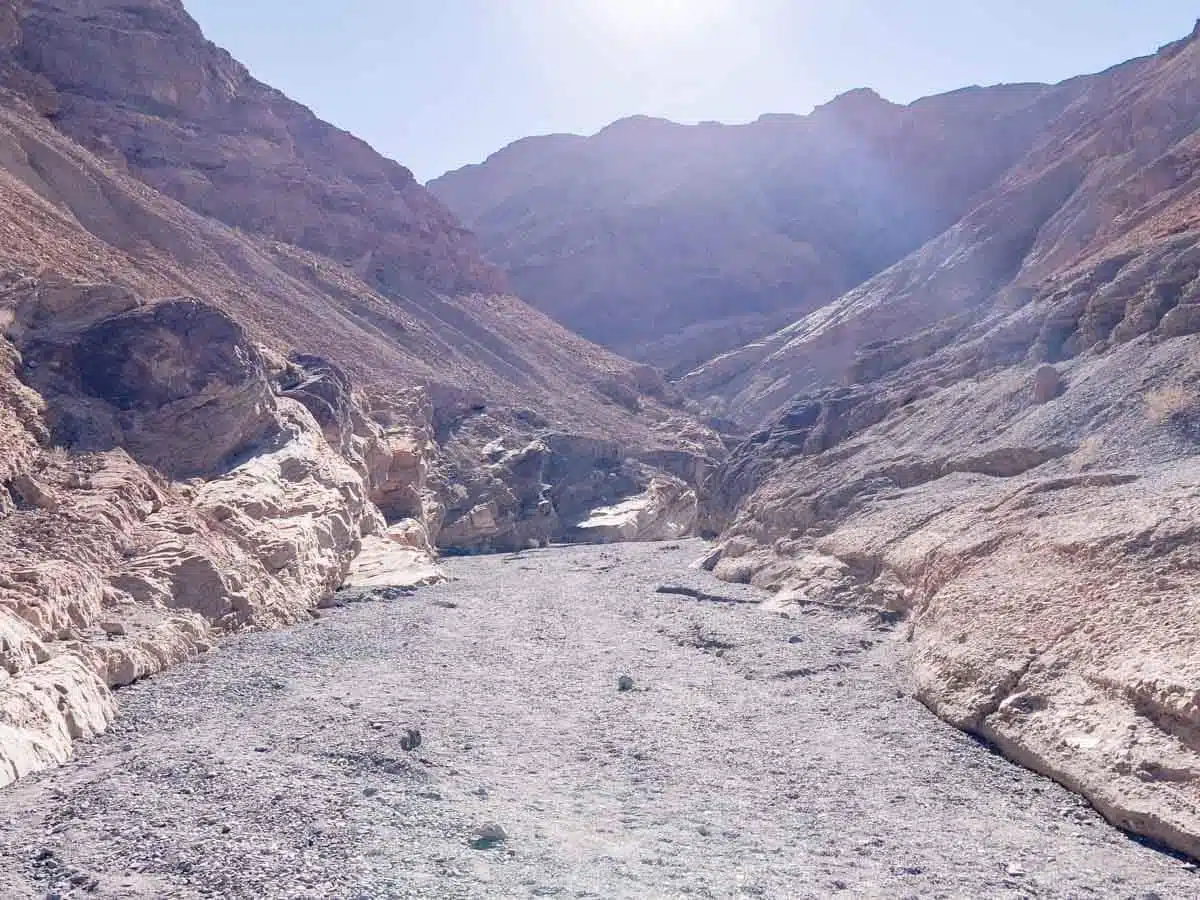
Newsflash! There are tonnes of hikes in Death Valley and tackling as many as you physically can is one of the most fun things you can do during your visit.
Don’t stress though – many of the hikes, including Mosaic Canyon are relatively easy and big enough on the wow factor to keep you distracted during the uphill stretches.
This moderate 4-mile hike takes around 2-3 hours, with plentiful snapshots of shiny slickrock and gleaming marble that give the canyon its name.
Kick things off by delving into the narrow canyon, which twists and turns before opening up into a wider plain. Safe to say that this hike isn’t short on different views and perspectives, and there’s just enough rock scrambling to keep things interesting.
See the Lee Flat Joshua Tree Forest
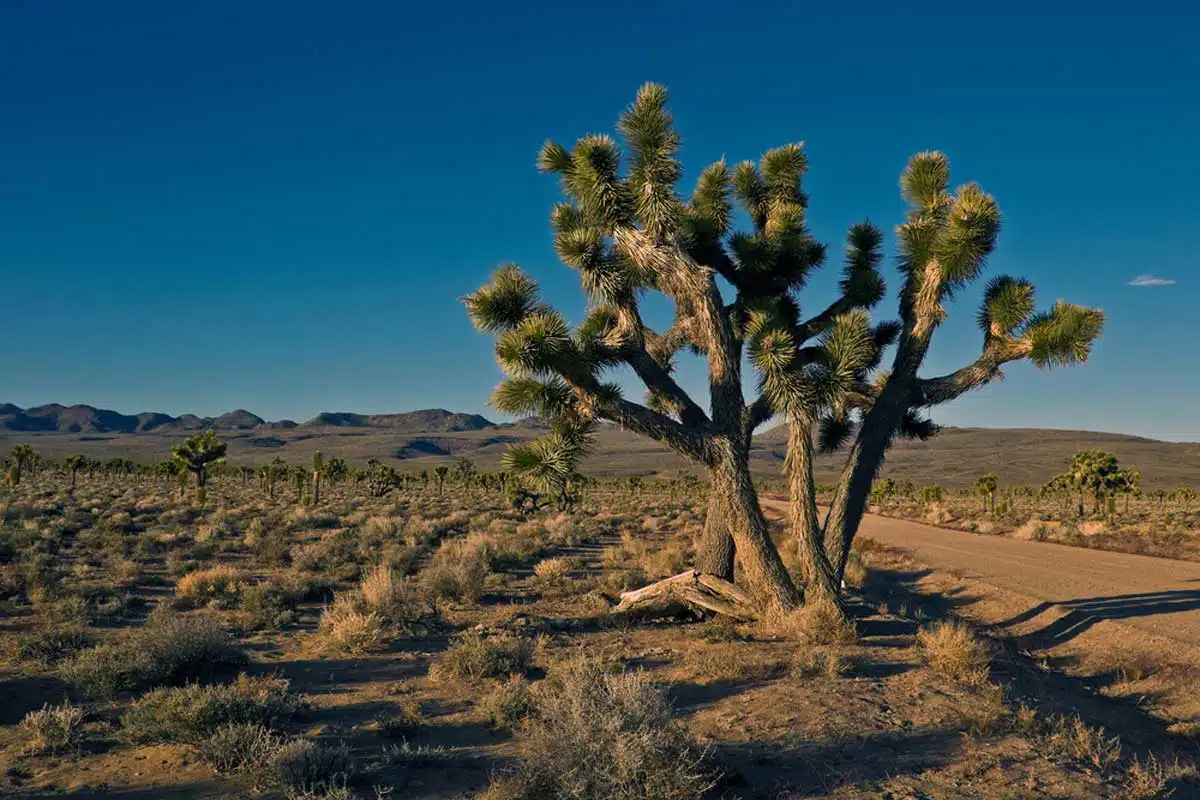
That’s right, folks — Joshua Tree National Park isn’t the only place to spot the weird and wonderful specimens of flora that are Joshua Trees.
Death Valley has its own Joshua Tree forests, the largest of which is the Lee flat Joshua Tree Forest. It’s near the western entrance to the park and sits at a higher elevation than the valley floor.
This means it has an almost completely different climate to what you find at Badwater Basin — a difference of 20°C or more in temperature between the two isn’t uncommon.
Visit at sunset, when the golden hues sweep over the brush and trees from across the purple mountains.
Set Off on the Golden Canyon and Gower Gulch Hike
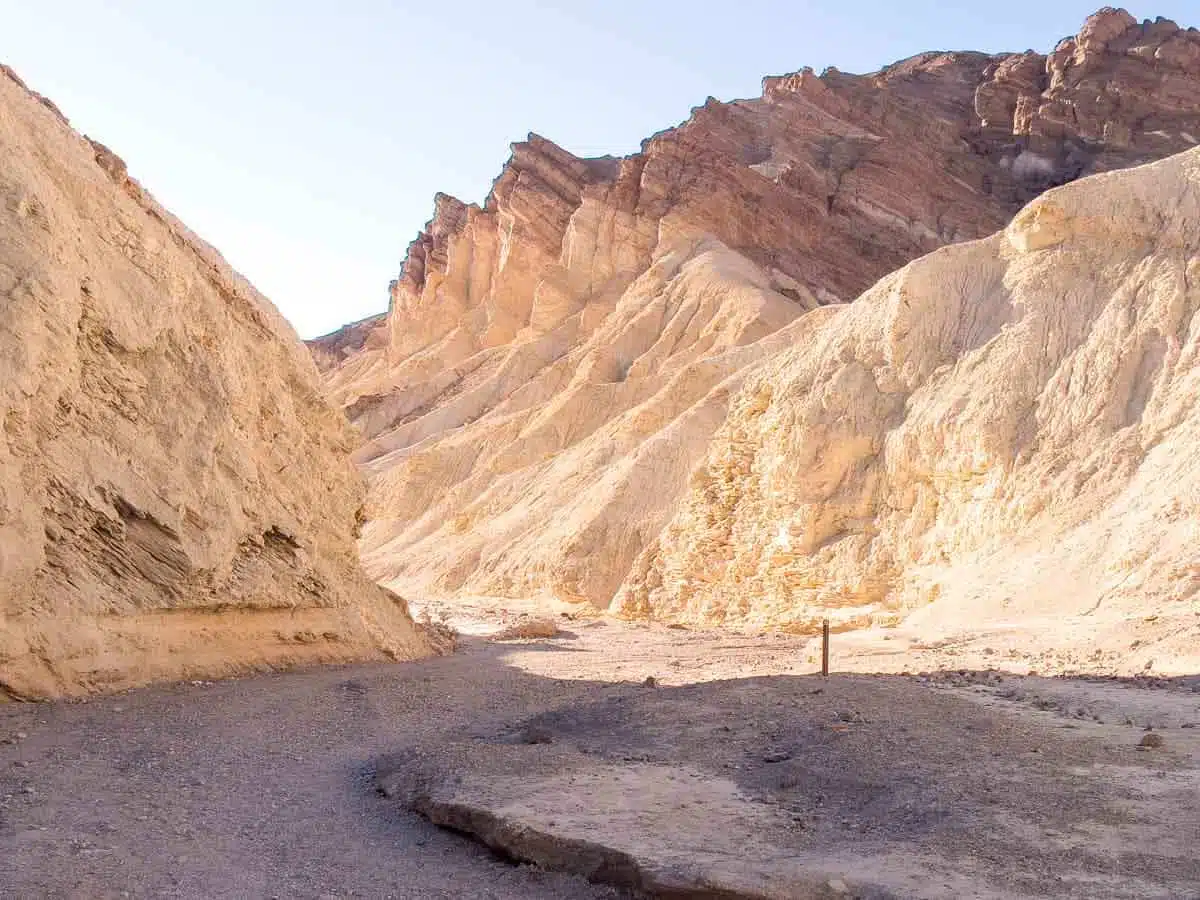
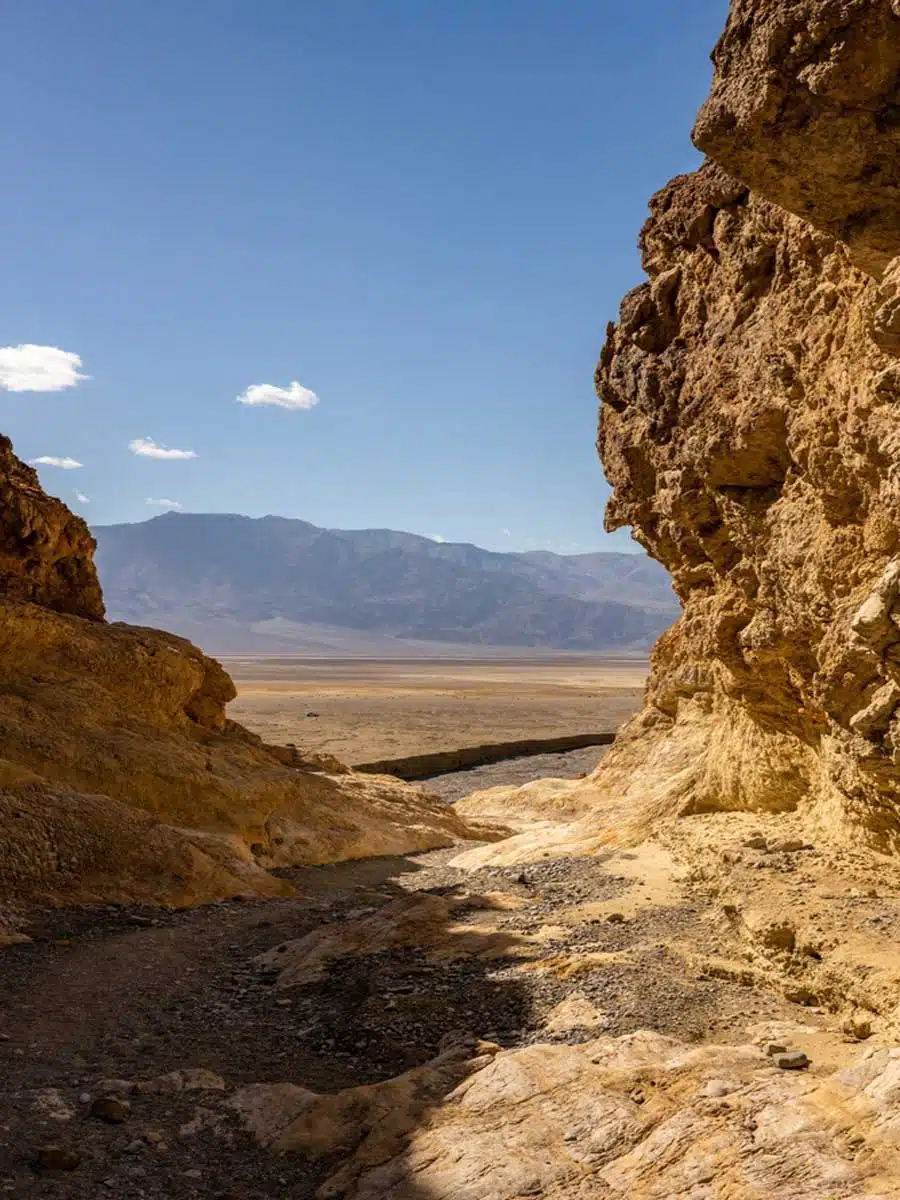
The Golden Canyon and Gower Gulch Hike is a relatively easy hike at 4.4 miles long and is a must if you’re visiting Death Valley for the first time. It’s one of my favourite easy out-and-backs in the park.
There’s only a little elevation and a bit of scrambling at the end – expect for it to take 2-3 hours in total – more if you stop to gawp at the fantastic views of the valley as I did.
The hike is named after the golden mudstone that makes up the beautiful formations that surround you during the larger part of the hike. I’m willing to bet that you’ve never seen as many shades of red and orange fanned out across one landscape.
Continue on towards Manly Beacon for the most exciting (and difficult) part of the trail, which comes with stunning views — they even rival even the grandeur of Zabriskie Point with their multicoloured formations.
Visit the Harmony Borax Works
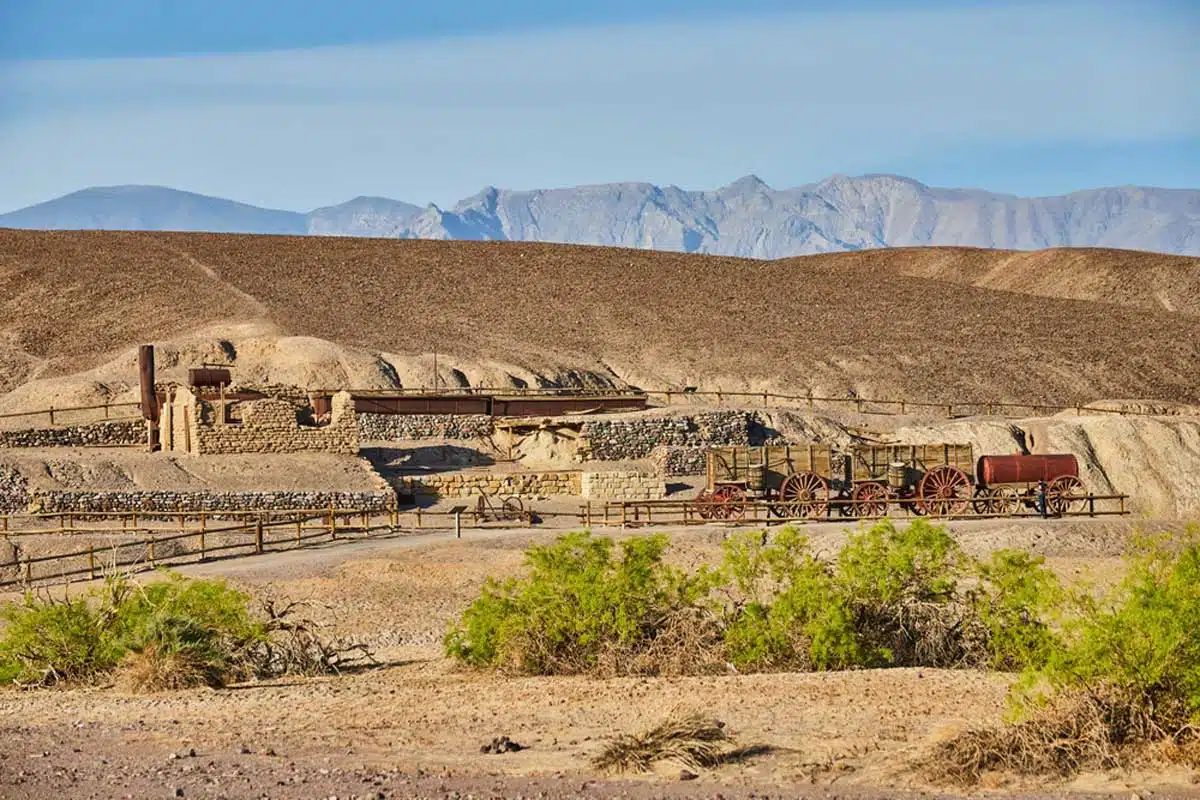
Any history buffs here? Death Valley might be best-known for its eye-popping landscapes, but dig deeper and you’ll find a rich seam of historical sights and the tales that go with them.
The Harmony Borax Works are one such place. By the late 19th century, Borax had come to be known as the “white gold of the desert” thanks to the fact that it was used in an increasing number of important products. This, in turn, kicked off a wave of prospecting in some of the country’s harshest locations – including (you guessed it) Death Valley.
Aaron Winters found borax on this site in 1881 and sold his claim to William T. Coleman, who built the Works where they refined borate-bearing mud until 1888. Although Borax was still in high demand, the difficult logistics of the site led to the works’ closure at that time.
Take a stroll around the site, taking in crumbly adobe walls, the old broiler and a couple of old wagons that have lasted the test of time, the last witnesses to a bygone era.
Cruise Along Artist’s Drive & Artist’s Palette
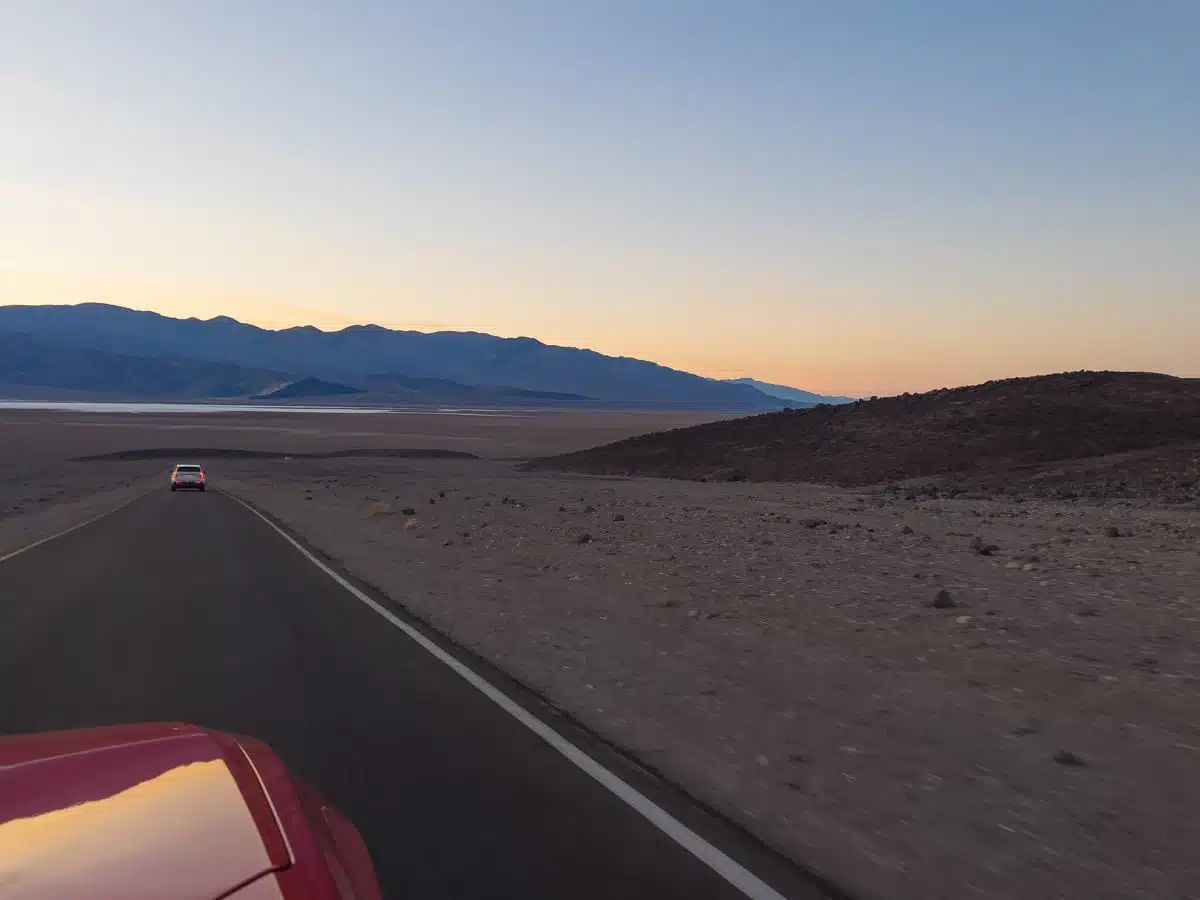
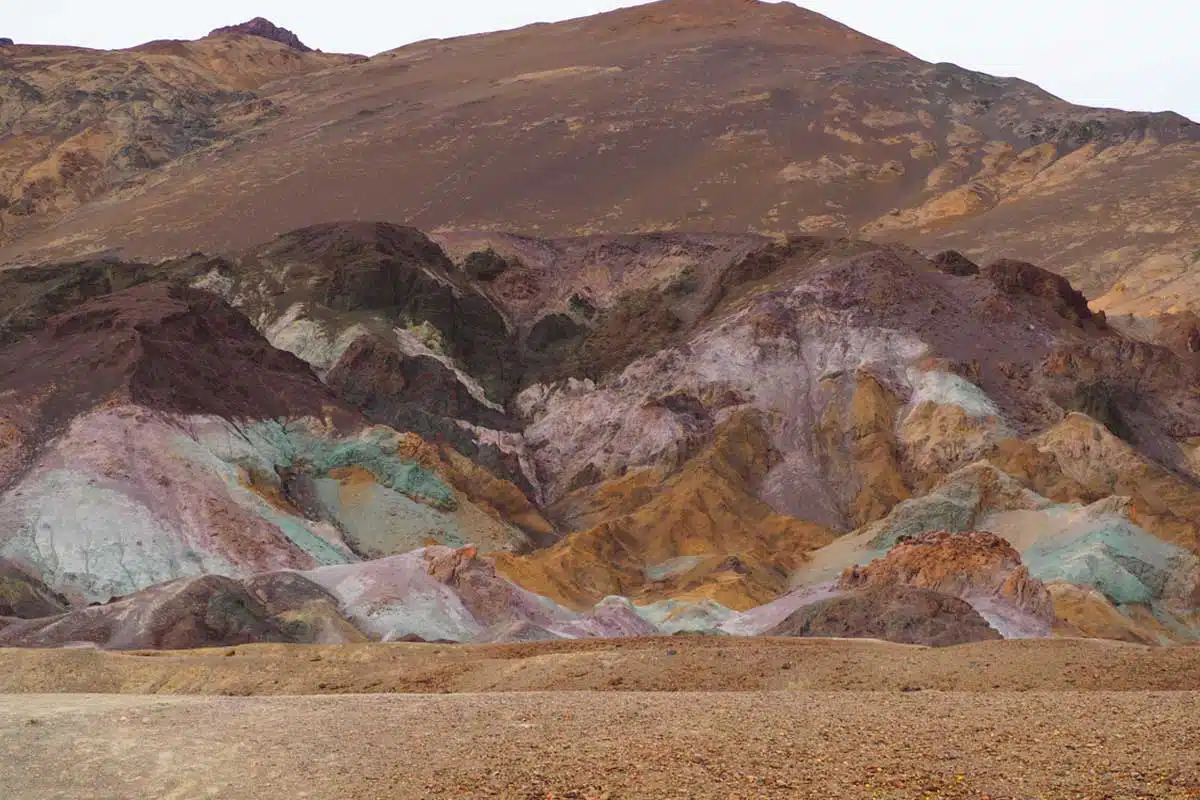
Another one of my highlights in Death Valley, Artist’s Drive is a 9-mile-long drive through some of the park’s most unique and scenic landscapes.
Although it offers plenty of spots for opportune photo-taking, stopping at Artist’s Palette is one of the best things to do in Death Valley by a long shot.
The hills change from brown and orange to a mix of pink, aqua, purple and white – the result of the oxidation of different metals in the soil. There’s a parking lot nearby, so you can ogle the gorgeous site up close.
Top Tip
Artist’s Drive runs from south to north and is one-way. The drive takes about half an hour without stops but factor in more time to be able to get out and explore.
Hike to Natural Bridge
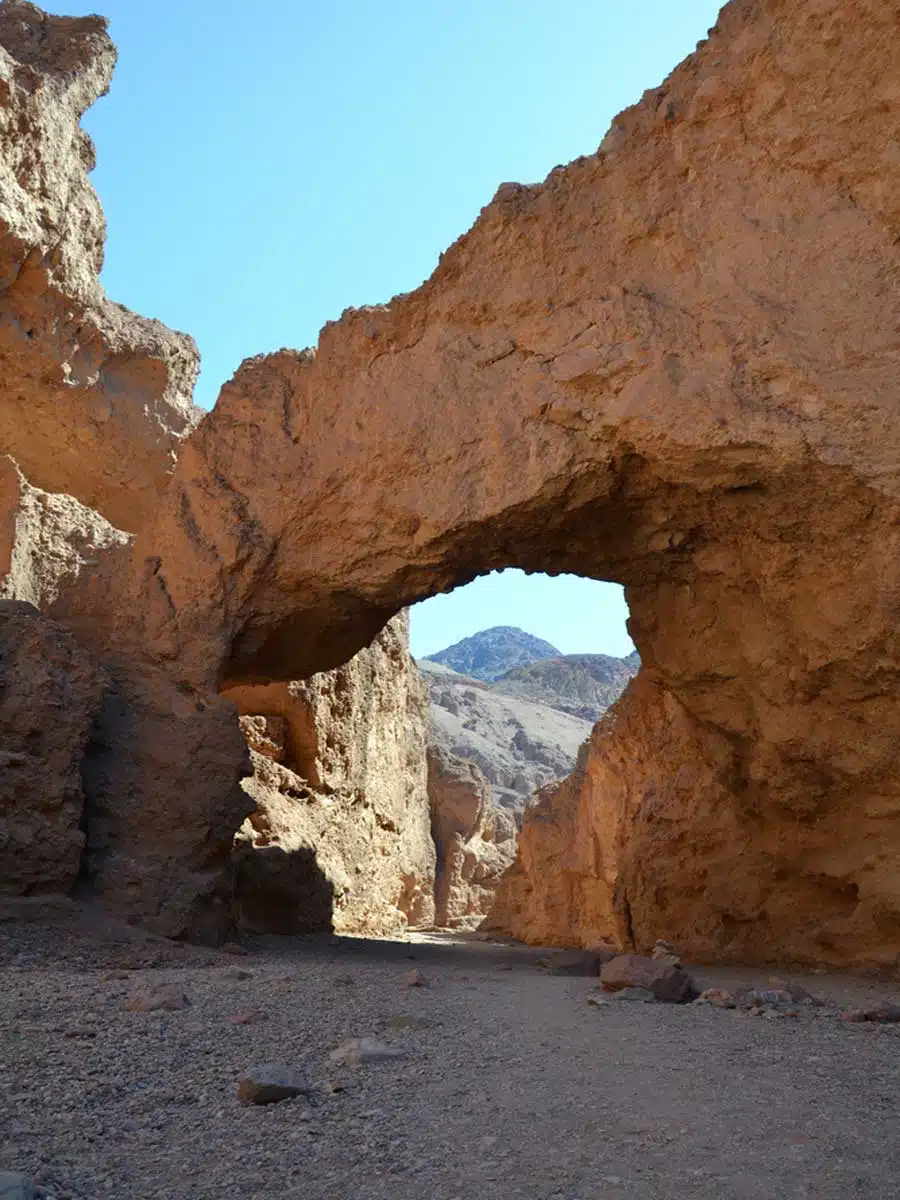
Make time to hike out to Natural Bridge – one of the many unique geological features within the park. It’s not far from Badwater Basin and is only about half a mile from the parking area.
The hike is fairly easy and takes about an hour. I won’t lie, as the actual hike goes, it’s not one of the most exciting in the park, but it’s worth it to see the Natural Bridge.
This isn’t a hike to tackle midday, though — early morning or late in the afternoon is better to avoid being in direct sun for the entire trek.
Getting There
Head south on Badwater Road from Furnace Creek. The well-marked turnoff to the trailhead on Natural Bridge Road is about 13 miles along. The bridge is 0.5 miles along an easy path from the trailhead.
Take the Twenty Mule Team Canyon Road Scenic Drive
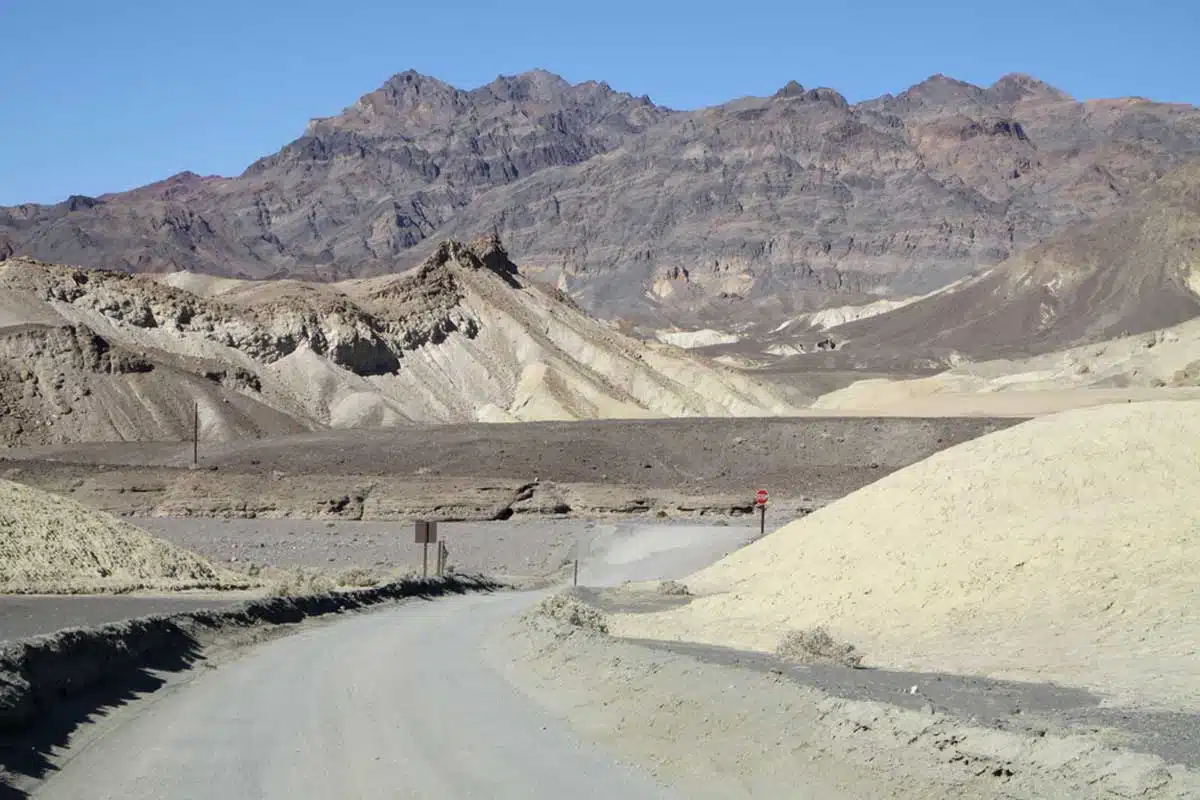
A one-way road through white and yellow mudstone hills, you might think a 30-45 minute drive through Twenty Mule Team Canyon could be a bore.
But the landscapes it offers are incredible! No desert brush obscures the gorgeous rock formations here.
Many small hiking trails splinter off the road, so you can park up and tackle those you fancy for even more epic views of the wind-carved mudstone from the top.
Go Stargazing
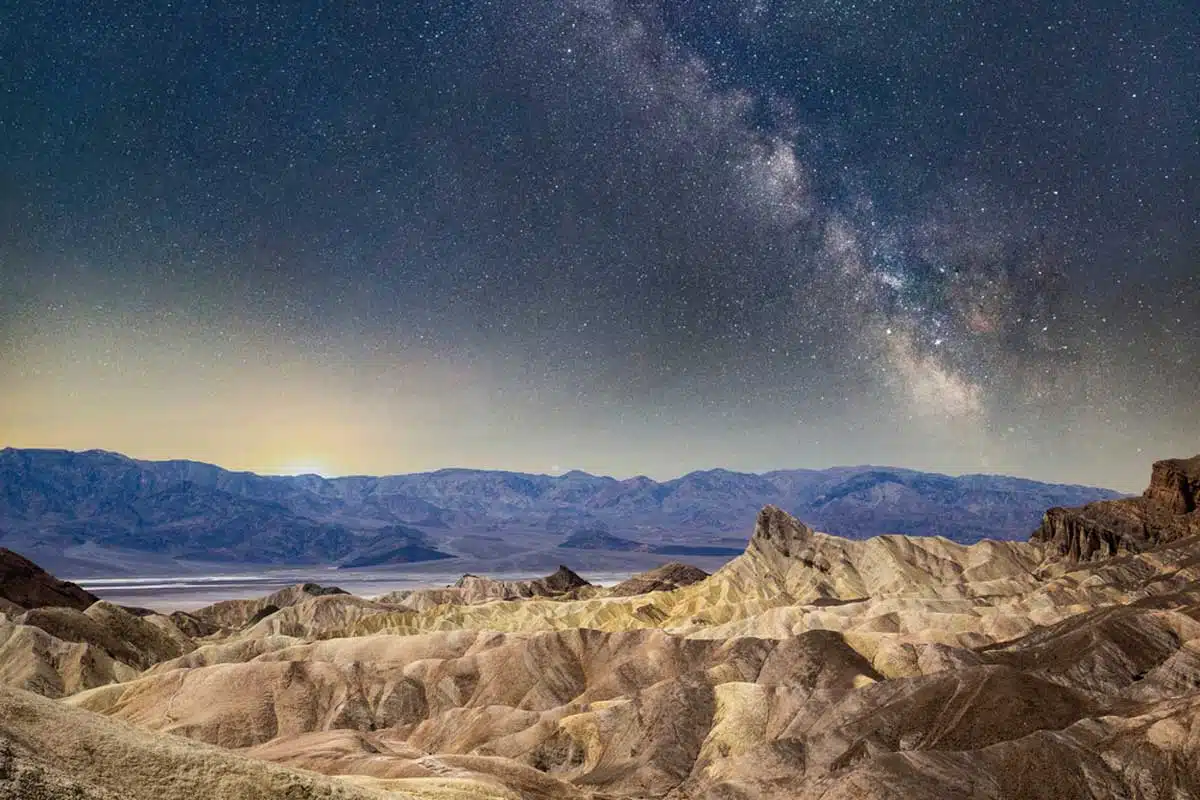
Death Valley has been designated as a Gold Tier International Dark Sky Park, meaning it’s one of the top places for stargazing, not only in the United States, but in the world.
It’s no secret how much I love watching the wonder of the night skies and the nights I spent stargazing in the park were unforgettable.
You can’t really go wrong with locations – if you can see a large stretch of sky, chances are it will be a good place. That said, Badwater Basin, Mesquite Flat Sand Dunes and the Harmony Borax Works are all great choices. Bring your camera for epic nighttime Milky Way photography.
Do
The park often hosts star parties during the winter months, where rangers and astronomers guide visitors through the wonders of the night sky via telescope viewings, guided walks and talks. Check the park’s calendar for upcoming events.
See Darwin Falls
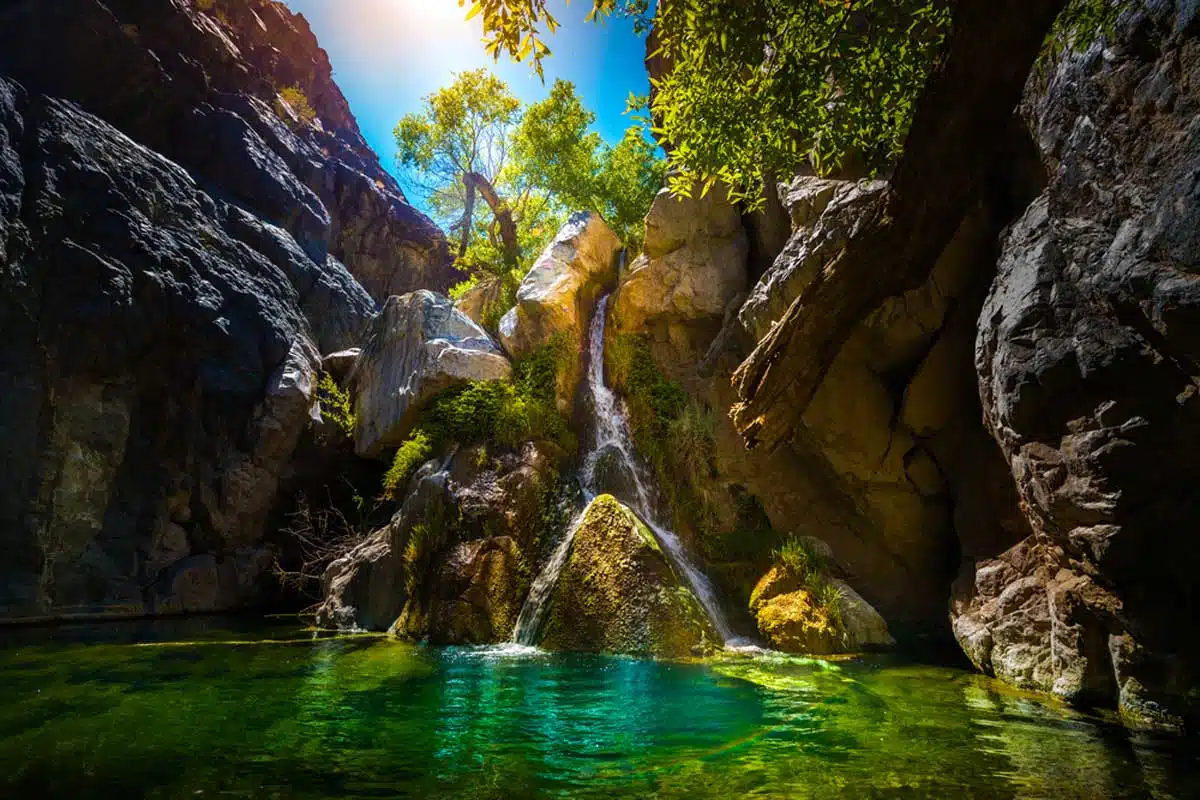
Believe it or not, Death Valley National Park, one of the hottest places on Earth, has a year-round waterfall, Darwin Falls.
That fact alone makes Darwin Falls a must-see spot. Sure, you’ll have to hike along a trail to find it… one so dry that you might doubt that it exists at all, but eventually, you’ll see a small creek complete with dragonflies and frogs croaking.
That’s the first sign of what’s to come – an unlikely waterfall surrounded by greenery that wouldn’t look out of place in the Amazon. Unsurprisingly, it’s a hub of biodiversity in the park, with plants and animals not found elsewhere in Death Valley, surrounded by willows and cottonwoods.
While most visitors make it to the Lower Falls and leave it at that, you can also hike to the Upper Falls. It’s a bit more challenging but is also a lot more secluded.
Do
It’s an easy 2-mile (3.2km) round trip hike from the Darwin Falls parking area. Wear sturdy footwear as the trail is quite rocky.
Take a Trip to The Eureka Dunes
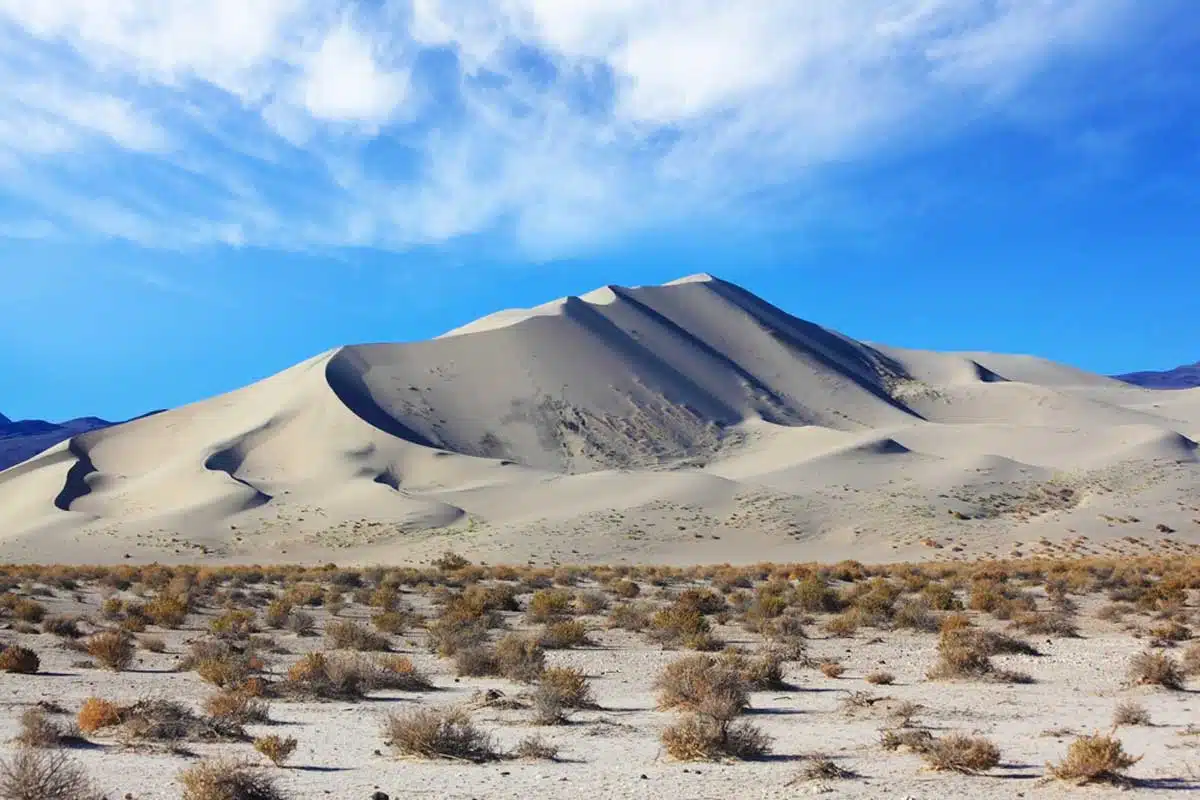
I know I talked about the Mesquite Flat Sand dunes earlier in this guide, but you should also make time to see their quieter counterparts, The Eureka Dunes.
The Eureka Dunes are more remote, but IMHO they’re the most beautiful dune field in Death Valley.
Located at an elevation of 914-metres, they’re the tallest dunes in California, framed by the stunning backdrop of the Last Chance Mountains.
The most curious thing about them though? They sing.
Yes. The dunes sing. It may not be the latest Taylor Swift hit, but under the right conditions, they sound out with a bass reverberation similar to a pipe organ emanating from under your feet. Who wouldn’t want to experience this baffling phenomenon that has scientists scratching their heads?
Top Tip
Prepare yourself for some challenging climbing when you visit Eureka Dunes – they’re tall and climbing them is a mean task. Bring lots of water, wear a hat and pile on the sunscreen.
See the Skidding Stones at Racetrack Playa
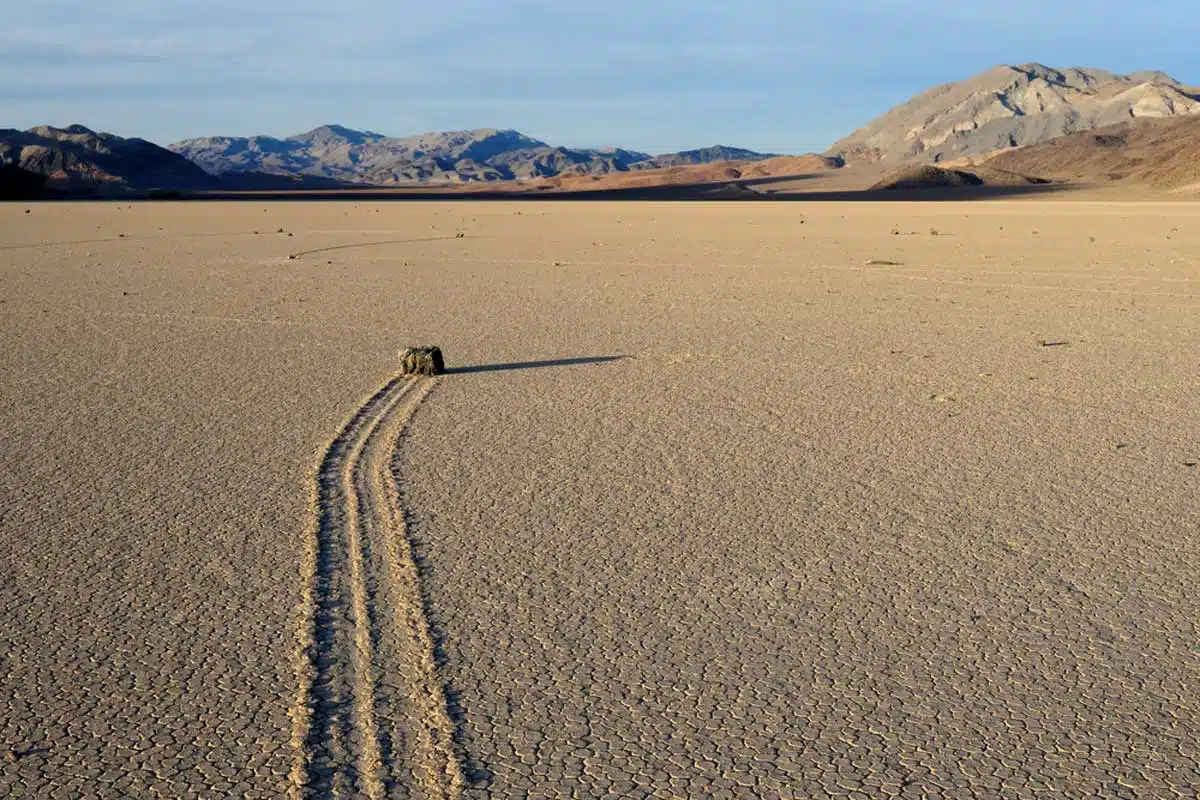
I think that by now we’ve established that Death Valley has more than its fair share of slightly… bizarre places, but Dunetrack Playa is up there with the best.
Perhaps you’ve heard of them — the mysterious large rocks that seem to glide across a dry lakebed, leaving enigmatic trails behind them though no one ever sees them move.
They’re called the sailing stones and how they manage to move was kind of a mystery. Scientists have been studying them since the early 1900s to figure out this phenomenon, and it seems that in 2014 they finally sorted it out, attributing the movement of the stones to a unique interplay between ice, water and wind.
Driving the 27 miles over the unpaved road in a high-clearance 4×4 is a small price to pay to see the Racetrack and its slow-motion racers.
Top Tip
The playa surface is fragile, so stick to the roads and don’t touch the stones. Also, bring a spare tyre or two just in case — that road can be brutal.
Do the Grotto Canyon Hike
The Grotto Canyon hike is a 2 – 4 mile round trip hike that you should try if you like a challenge.
It’s a quiet trail that navigates through narrow canyons and will have you scrambling over difficult obstacles. The first half of the hike sees you through a canyon, climbing over some tricky rock sections.
About halfway, you’ll hit a 2.4-metre chimney — it’s the “oh hell no” point of return for many hikers. But if your legs are up to the climb, give it a go and complete the hike.
See The Charcoal Kilns
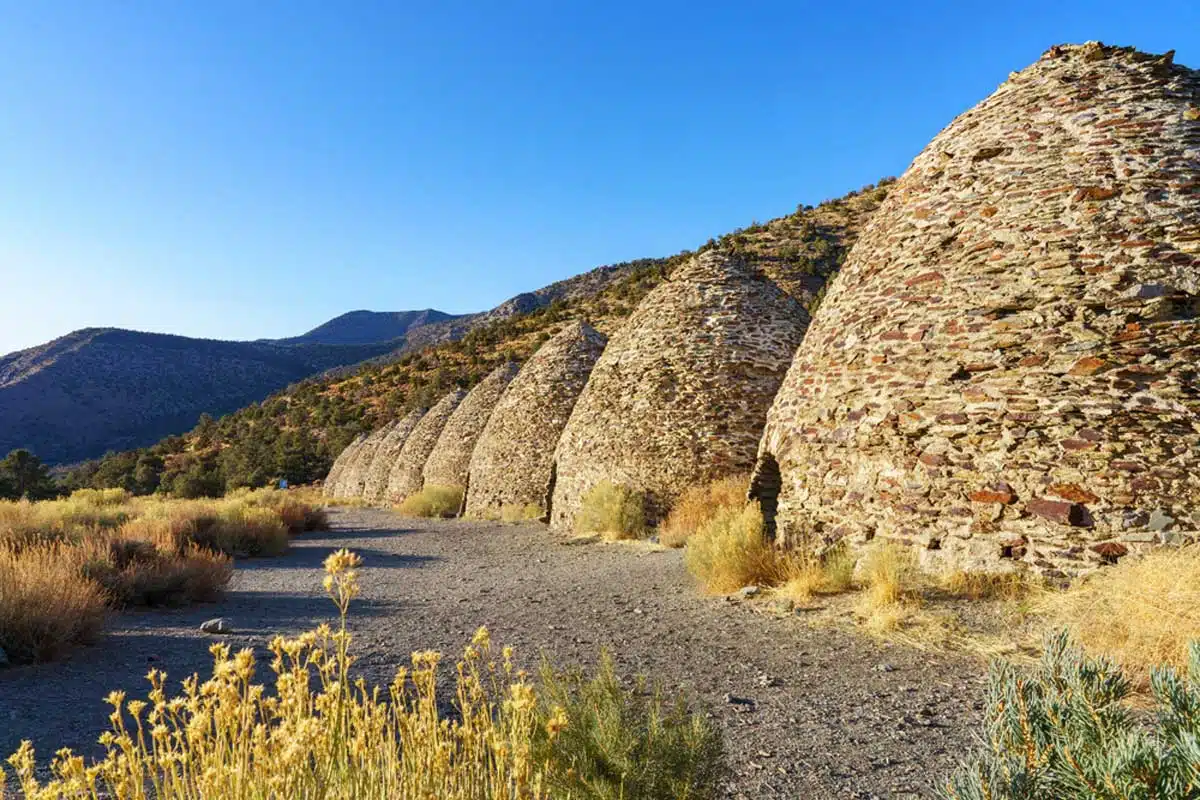
One of the more unusual things to do in Death Valley is to visit the charcoal kilns.
The kilns’ interesting conical beehive appearance with bits of dry scrub surrounding them gives off the vibe of a quirky abandoned village. They were in use back when the park was a mining hotspot to create charcoal.
Getting There
You can find the Charcoal Kilns in the Wildrose section of Death Valley, but beware: the road to the kilns is bad, so a high-clearance or a 4WD vehicle is necessary to reach them.
Head Out to the The Ibex Dunes
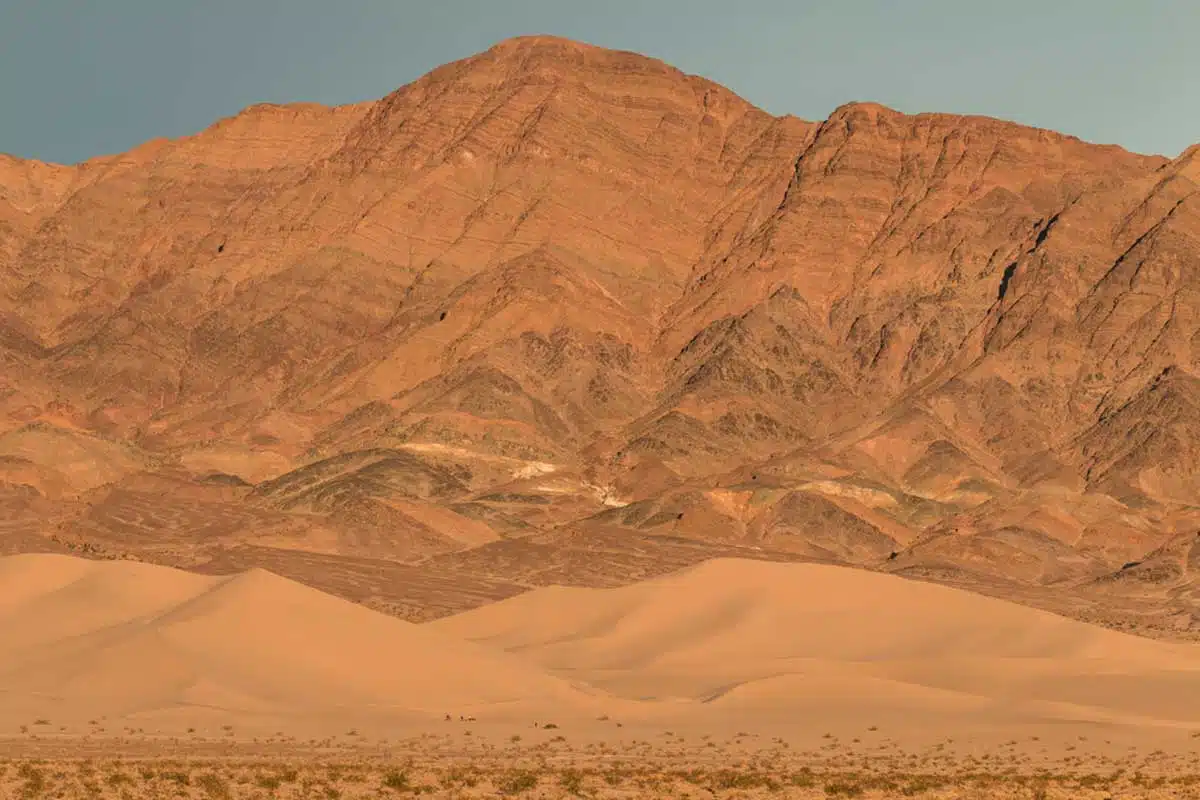
The Ibex Dunes are pretty remote, making them ideal for photography enthusiasts. It helps that they’re naturally superbly photogenic, too.
There’s an abandoned mine on the far side of the dunes by the mountain, an eerie reminder of days gone past and a great photo spot.
Heading out on the high-clearance road to explore the isolated dunes is one of the cool things to do in Death Valley, but do it early in the day. Even in winter, it gets hot quickly out there, and you wouldn’t want to end up in a dangerous situation.
Practical Tips for Your Death Valley Trip
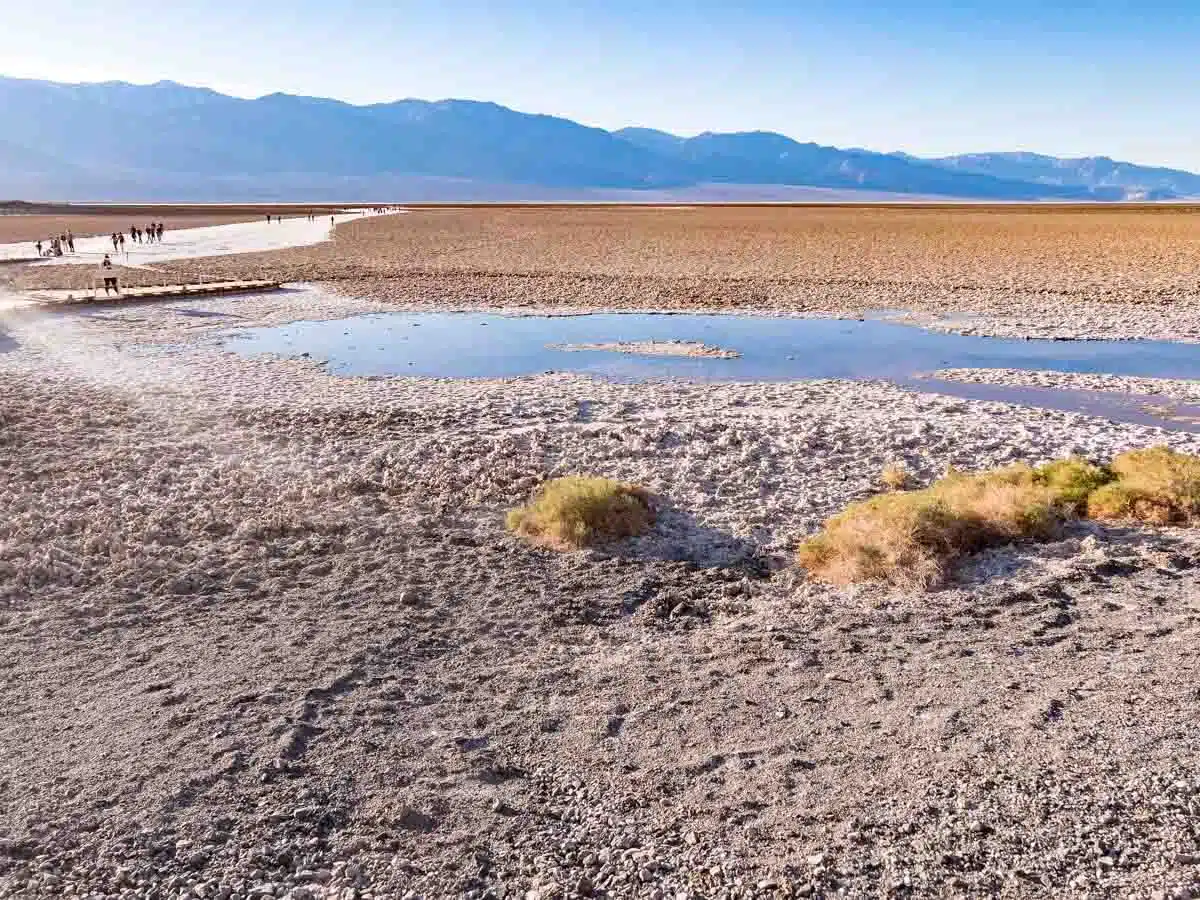
Tickets
A standard entrance pass for a car to the park is $30 and is valid for a seven day period. Passes can be purchased from several locations in the park, including the Furnace Creek Visitor Center.
More than other places in the US, a little bit of planning goes a long way in Death Valley National Park.
The park’s main hotel, the Inn at Death Valley, books up well in advance, as do other hotels in the surrounding areas.
Then there’s the flooding and access. The park’s unique geography can lead to sudden and intense flash floods which can cause extensive damage to roads and landscapes – as illustrated in summer 2023 and the ensuing chaos of Burning Man.
Be very cautious if you’re visiting the park during a rainfall – even if you’re not, ensure you’re up to date with the current situation via the National Park Service’s website.
Other Top Tips for Your Visit
- There’s little to no mobile reception across most of the park. Buy a paper map or use the free map from the Visitor Center and ensure you let someone know your plans before heading to a remote area.
- Ensure you’ve filled up your tank prior to going into the park and keep a close eye on gas levels as you drive around. There are two gas stations – at Stovepipe Wells and Furnace Creek but both are more expensive than those in the surrounding areas.
- Sun protection is key – wear light, loose-fitting clothes to help keep you cool during the day.
- Stay hydrated – 4-8 litres per person per day is recommended thanks to the dry desert air and high temperatures.
- Stay on designated paths and preserve the park’s delicate ecosystem. It also helps you steer clear of hazards like old mines and unstable ground.
How Long Should I Spend Visiting Death Valley National Park?
While it’s possible to see Death Valley’s highlights in one day, it will be a rush. Plan to spend two to four days to see the park’s main sights at your leisure – or even a week if you want to include lots of hikes.
Best Time to Visit
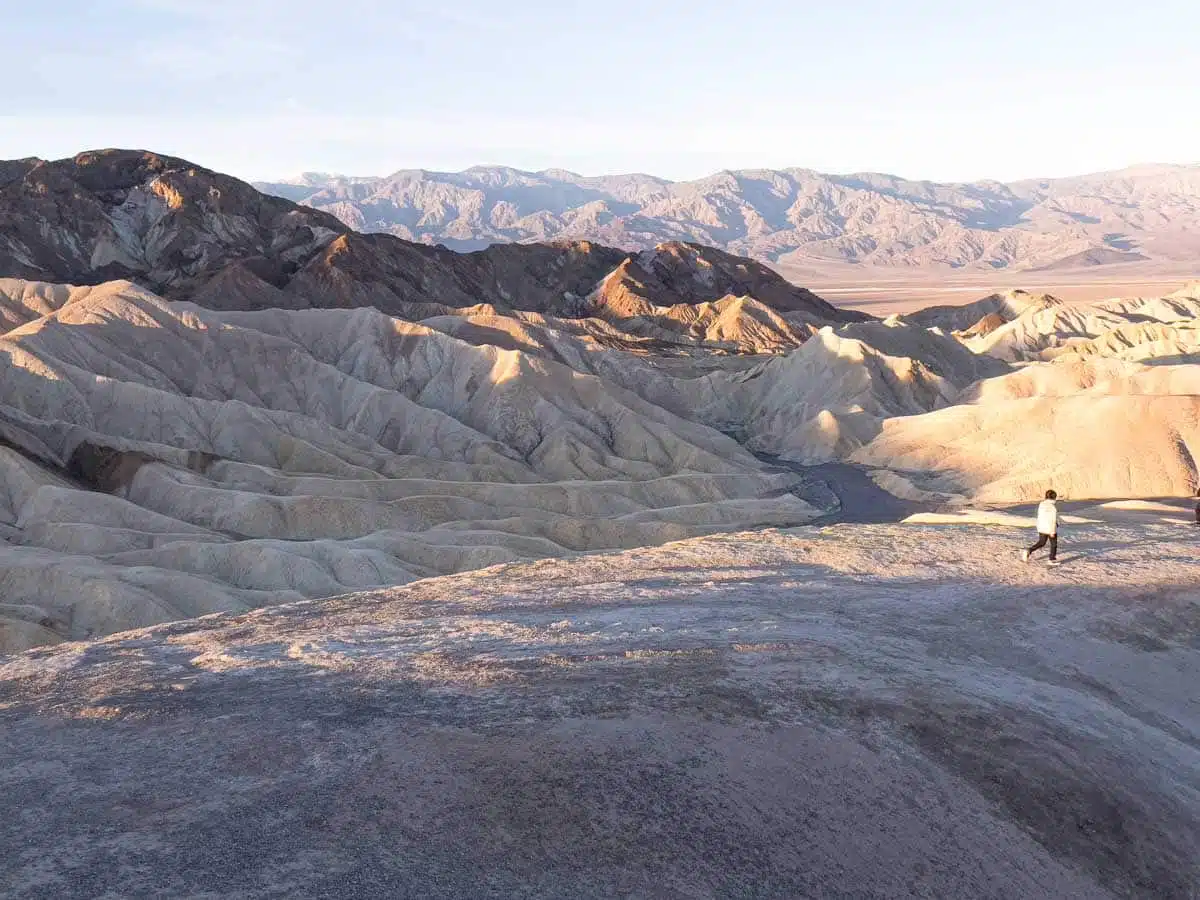
The best time to visit the valley is undoubtedly in spring, from March to May when days are warm and sunny but steer away from the unbearable temperatures of mid-summer. It’s also the most popular time, so don’t be surprised if many of the most popular spots are a bit busy.
Spring is also when the wildflower blooms take place – peak blooming time is late March to early April.
Where Should I Stay in Death Valley?
Holiday Inn Express & Suites (Mid-Range)
Although it’s not in Death Valley, the Holiday Inn in Pahrump is an unremarkable, if decent mid-range option with crisp modern rooms. It’s the best-value option near the park, which is only 24 miles away.
Check Rates and Availability for Holiday Inn Express & Suites on Booking.com
The Inn at Death Valley (Luxury)
Located inside Death Valley National Park, this luxurious hotel has all the trimmings. It is a beautiful place and offers a sauna, outdoor pool, bar and air-conditioning in the rooms. With uber-comfy beds and lush lawns and palms before the mountainous backdrop, you won’t want to leave.
Check Rates and Availability for The Inn at Death Valley on Booking.com
Recommended Tours
Recommended Tours
Things to Do in Death Valley: Map
Read More Death Valley National Park Guides
- 3 Days in Death Valley National Park Itinerary
- Where to Stay in Death Valley, Area by Area
- When’s the Best Time to Visit Death Valley National Park?
- Stunning Hikes in Death Valley You Have to Try
- Where to Catch Epic Sunrises and Sunsets in Death Valley National Park
Love This? Save and Share on Pinterest
